SOIL


www.GolfKitchen.com March 2021 - August 2021 DOMINIC CALLA ROUND HILL CLUB REYNOLDS LAKE OCONEE THE CLUBSHELP STORY BALTUSROL GOLF CLUB ED STONE
IN WINE EXCELLENCE AT GLENARBOR GOLF CLUB DERIN MOORE COVER STORY LOCAL & HEALTHY AT ROYAL POINCIANA GOLF CLUB
TRADITIONS
IS
CHEF’S GARDEN
THE HEARTOF THE
Golf Kitchen Magazine is a biannual publication of Golf Kitchen LLC. Copyright 2021. Print subscriptions are available at www.golfkitchen.com for $59.99 per year.
All rights reserved in all countries. Contents may not be reproduced in any manner without written permission of Golf Kitchen LLC. Golf Kitchen LLC does not necessarily agree with the viewpoints expressed by our contributing writers of articles and advertising copy.
For advertising opportunities please email us at info@golfkitchen.com
Golf Kitchen welcomes letters to the editor at info@golfkitchen.com
GOLF KITCHEN Magazine

COMING SOON

CLUBHOUSE COCKTAILS
PRESENTED BY GOLF KITCHEN
HOST
SHAUN C. LEWIS OF LIBERTY NATIONAL GOLF CLUB



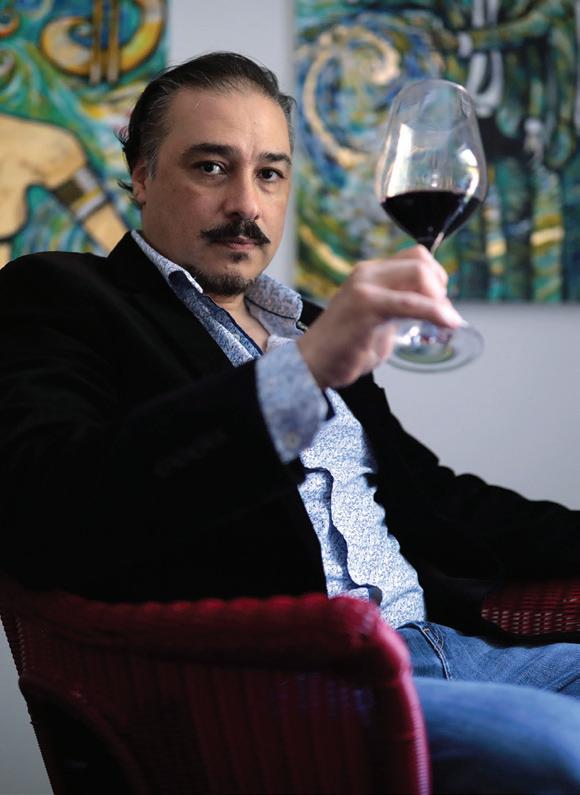
41 48 CONTENTS MARCH 2021 | AUGUST 2021 52 TRADITIONS IN WINE EXCELLENCE AT GLENARBOR GOLF CLUB WITH FERNANDO SILVA 94 COVER STORY: DOMINIC CALLA EXECUTIVE CHEF AT ROUND HILL CLUB 14 DERIN MOORE, CMC EXECUTIVE CHEF REYNOLDS LAKE OCONEE 48 THE CLUBSHELP STORY 14 52
Data Management Redefined

More than 80 percent of enterprise data is scattered across multiple locations on-premises and in public clouds, trapped in infrastructure silos, and buried unseen in long forgotten storage systems, making it almost impossible for IT to control – still less exploit for business advantage.


Cohesity eliminates this mass data fragmentation problem with a web-scale, data management platform that radically simplifies the way companies protect, control and extract value from their data. This software-defined platform spans across clouds and data centers, can be managed from a single GUI, and enables independent apps to run in the same environmentjust like the smartphone.

Learn more about Cohesity at cohesity.com © 2020 Cohesity, Inc. All rights reserved. Cohesity, the Cohesity logo, SnapTree, SpanFS, DataPlatform, DataProtect, Helios, and other Cohesity marks are trademarks or registered trademarks of Cohesity, Inc. in the US and/or internationally. Other company and product names may be trademarks of the respective companies with which they are associated. This material (a) is intended to provide you information about Cohesity and our business and products; (b) was believed to be true and accurate at the time it was written, but is subject to change without notice; and (c) is provided on an “AS IS” basis. Cohesity disclaims all express or implied conditions, representations, warranties of any kind. Run Apps One UI One Platform
“Cohesity is committed to continuous innovation, consolidating and simplifying the management of data centers and clouds. That’s how we are going to help change the world.”
MOHIT ARON, CEO





58 CONTENTS 86 BUY LOCAL AND KEEP YOUR MENU AS FRESH AS THE FOOD 124 CLUBHOUSE COCKTAILS 58 ED STONE EXECUTIVE CHEF BALTUSROL GOLF CLUB 90 THE CHEF’S GARDEN 86 90
FROM THE EDITOR
Hello all,
What an interesting 12 months! This time last year, I was in Naples, Florida, working on my book and magazine stories when the news of the pandemic hit; regretfully, I had to make immediate plans to return to Stamford, Connecticut.
Fast forward 12 months, and what a journey it has been for all. Many of us chatted with each other about how to move through this pandemic successfully. We built support networks and lifted each other up when times were seemingly hopeless.
We formed positive new concepts and developed new friends and business relationships, many that will blossom for years to come. Now that we can see some light at the end of the tunnel, it is important to stay the course. There will be ups and downs, but one general manager in North Carolina said it best, “We are prepared to operate at any capacity that the law and guidelines permit at a moment’s notice, we are fully aware that things will likely be up and down for the coming months or even years.”
Over the last 10 years, I have learned to bounce back time and time again after many setbacks and heartbreaks. The extensive time to myself this past year has forced me to know and accept myself, flaws and all. I am stronger and fiercer for it and closer to my children and family than ever. I was inspired to return to distance swimming and regain my fitness. It is a daily ritual now, Monday through Fridays, and it’s been a gamechanger for me personally.
I look forward to continuing to build the Golf Kitchen family and community that we have all worked so hard to develop. Every story produced is a collaboration between the club, chefs, culinary teams, marketing departments, and Golf Kitchen.
With that in mind, let’s delve into this issue!
I had always been intrigued by the elusive Round Hill Club in Greenwich, Connecticut. Still, I never thought I would be blessed to be the only publication permitted to produce a culinary piece at the club. Dominic Calla, the Executive Chef, and our cover story, has worked very hard to gain this position at this prestigious private golf club. He brings many educational opportunities to his team, and it is interesting to note that he has a dry-aging room and is currently teaching his staff how to prepare house-made charcuterie, which is a lengthy process that I was completely unaware of. We will share this process with you on the Golf Kitchen website for those who are interested.
About 10 years ago, I met Karen Moraghan of Hunter-PR at the PGA Show in Orlando, and during this pandemic, we began to work together on various projects. One that I am particularly proud of is ClubsHelp. I am pleased to run “The ClubsHelp Story” that Karen and her team have produced. Please, I encourage you to sign up your club for this exciting new fundraising concept whose mission is to connect golf and member clubs with local communities to activate a powerful network that provides critical resources in times of need.
I had been aware of Reynolds Lake Oconee in Georgia for many years. Once Covid restrictions were relaxed, I jumped at the opportunity to work with the Reynold’s marketing team and Derin Moore, CMC, Executive Chef, and Restaurant Chef Zouhair Bellout, to produce a stunning piece on the culinary prowess at this property and showcase the properties beauty.
Farmer Lee Jones and I met at a City Meals on Wheels event at Rockefeller Center in Manhattan over 15 years ago, and we initially had an unusual relationship. I was new to the NYC scene and could not understand who this gentleman in overalls and a red bow tie was. Well, that said, I can tell you, as most of you know, he has a heart of gold and a passion for the land, soil, nature, and his many customers. He has had a challenging year, needing to do a strong pivot from supplying restaurants to delivering the Chef’s Garden’s premium product directly to your homes. Lee also lost his beloved father, Bob Jones, which further shook up the staff and the Jones family. We are looking
forward to showcasing Farmer Lee’s new book, “The Chef’s Garden: A Modern Guide to Common and Unusual Vegetables-With Recipes,” which will become available in April. Farmer Jones has shared one of his recipes in this issue. I am sure you will love to trying to make this one at home!
I enjoy a strong relationship with the team at GlenArbor Golf Club in Bedford Hills, New York, and thoroughly enjoyed working with Fernando Silva compiling a piece about “The GlenArbor Traditions in Wine Excellence Award” held annually. It was a great pleasure to have the opportunity to speak with Mr. Adam Strum, CEO/Owner at Wine Enthusiast magazine, Mr. Laurent Drouhin of Maison Joseph Drouhin, and Mr. Jean Charles Boisett, Vintner, Proprietor, and Wine Entrepreneur during production.
Golf History, like no other, can be found at Baltusrol Golf Club in Springfield, New Jersey. During my stay at this historic property with the largest collection of golf memorabilia, trophies, and paintings I have ever laid my eyes on it; I felt like royalty. Read about Ed Stone, the Executive Chef’s journey from Manhattan’s fine dining scene to this stunning property in New Jersey, and enjoy creating his fine food that the members regularly enjoy at the club.
More farm stories are popping up all over the country at private clubs. Executive Chef Jean Pablo de la Sota Riva Leal pens a piece about Royal Poinciana Golf Club’s farm initiatives on the property and off. Thank you, Chef, for your contribution to this issue. I will be seeing you in mid to late April with a special delivery!
Finally, I am excited to announce a new partnership with Shaun C. Lewis, Executive Chef and Assistant General Manager at Liberty National Golf Club, who will be the host of a new short video series, “Clubhouse Cocktails,” produced by Golf Kitchen. If you are a private golf or country club mixologist, cocktail equipment, beverage, liqueur, or wine company and would like to be featured, please contact us at info@golfkitchen.com for details.
Regards and be well!
Diana DeLucia President Golf Kitchen LLC diana@golfkitchen.com
806 406 1782

CONTRIBUTORS
Kelly Boyer Sagert is a content creator for The Chef’s Garden and Culinary Vegetable Institute, where she enjoys writing about regenerative farming, delicious vegetables, unique recipes and much more.
Contact Kelly: www.Chefs-Garden.com
Michael J. Fiedler is a professional Photojournalist, Entrepreneur, Artist, Author, and passionate Montblanc Collector. He has traveled the world, documenting everyday people in black-and-white photographs and his subjects handwritten stories.

Contact Michael: www.Working-Journal.com michael@michaeljfiedler.com
Executive Chef Juan Pablo de la Sota Riva Leal was born in Mexico City and studied at the Ambrosia Culinary Center. He later moved to Madrid, Spain for an internship in a two-Michelin-Star Restaurant called La Broche. Juan Pablo has worked at many prestigious restaurants before joining Royal Poinciana Golf Club.

Contact Juan Pablo: www.RPGolfClub.com
JPDeLaSotaRiva@rpgolfclub.com
Special thanks:
Karen Moraghan, Hunter-PR

Laurent Drouhin, Maison Joseph Drouhin
Jean-Charles Boisset, Vintner, Proprietor and Wine Entrepeneur
Adam Strum, CEO/Owner at Wine Enthusiast Magazine
Morgan Gregory, Presidient, GlenArbor Golf Club
Fernando Silva hails from Argentina and is the Sommelier at GlenArbor Golf Club in Bedford Hills, New York. Fernando has traveled the world extensively learning about fine wines. He is certified with the Court of Master Sommeliers and the American Sommelier Association and is a gifted artist.

Contact Fernando: fsilva@glenarborclub.com
Derin Moore, CMC, Executive Chef, and team at Reynolds Lake Oconee
Ed Stone, Executive Chef, and team at Baltusrol Golf Club
Dominic Calla, Executive Chef, and team at Round Hill Club

Reynolds Lake Oconee
Greensboro, Georgia

 The 16th green at Great Waters. Image Evan Schiller, courtesy Reynolds Lake Oconee.
The 16th green at Great Waters. Image Evan Schiller, courtesy Reynolds Lake Oconee.
Derin Moore, CMC Executive Chef Reynolds Lake Oconee
Reynolds Lake Oconee is one of the most stunning Golf Real Estate communities in the country, and to match the beauty of the community, they hired Derin Moore, Certified Master Chef (CMC), to upgrade the culinary elements from average to sensational.
~ Diana DeLucia
GK: Where did you grow up, and who, and what influenced your interest in cooking?
I was born and raised in Southeast Michigan, but I spent the summers with my grandpa in Orchard Park, New York. That’s where the spark of cooking and fresh food began. I was very young and one of six children, four boys, and two girls. I was the middle child. I loved my grandpa. He used to pick me up right from school, and then I’d spend the entire summer with him.
We were a large family, and every Sunday, he would always have people over for dinner. He had a big house, a vast garden, and a lot of land. We would plant and pick his garden all summer long. Grandpa did a lot of canning, and he would make creamed corn and jellies out of the fruit trees. There were always activities outside of the kitchen; however, I’d still be up making homemade muffins before church. As I got older, we did a lot of harvesting and cooking together.
When I was in 10th grade, Grandpa took me on a trip across the New York State Thruway to the Culinary Institute of America (CIA). He knew Joseph Amendola, a culinary mainstay at the CIA in Hyde Park, New York. Amendola gave me a tour of the facilities, and I was mesmerized; he
had such an extensive knowledge of his craft. He was known as the teacher who teaches the teachers. After a few days on the property, I was hooked.
GK: What year was that?
It was around 1982; at that time, the CIA was still relatively small. All the master chefs were there, including Ferdinand Metz, the President, Tim Ryan, and Mark Erickson. I had found myself in an ideal learning environment, and I was just 18. Many of the chefs in my class were older, and many were changing careers; they could all go out on the town, but because I was underaged, I just knuckled down and studied. It was a different school at that time, but it was an excellent education, and I made a lot of great contacts that I still have today. As time went by, I got on the United States Olympic Team while getting ready for my Master Chef exam. A lot of my instructors at that time became mentors and pushed me into the competition direction. I had graduated CIA by the time I was 20. After that, I returned to Michigan.
GK: What did you do next?
The Detroit area was bustling with higher-end cuisine and the integrity of good food and good cooking. There were many certified master chefs in Michigan, and I was able to easily find work in fine dining restaurants, where some of the best chefs could mentor me. These restaurants (The Bijou, The Pike Street Restaurant, and The Golden Mushroom) were all servicing celebrities such as Aretha Franklin, mainstay executives from the big three automotive companies, and sports teams. You don’t think of Detroit as a restaurant
INTERVIEW Golf Kitchen Magazine 16

town anymore, but there are many great clubs there. They’re trying to come back, but there was a lot more support with the big three being so successful, and the auto industry thrived. I was in the right place at the right time, and I learned from some of the best chefs in the area for 12 years. I worked with Brian Polcyn, who wrote three books with Michael Ruhlman about charcuterie. Milos Cihelka, who was like the godfather of sorts for most of the successful chefs in Michigan, mentored Brian Polcyn, who in return mentored me for eight years at Pike Street. My gosh, I got the benefit from those relationships in the Detroit area.
GK: Tell us about the ACF and US Olympic team competitions.
I had an opportunity to enter culinary competitions hosted by the American Culinary Federation (ACF). I competed in Chicago, Cleveland, New York, Philadelphia, and Detroit.

Everybody was competing in cold food competitions, and you’d get critiqued by Ferdinand Metz, Tim Ryan, and Mark Erickson. That was a precious experience, and it was fun to win gold medals. After that, I was invited to try out to compete on the US Olympic team. Keith Keough was the team manager and the ACF President. I traveled and competed from 1996-2000 on the National team. I was blessed to have traveled to Scotland, Switzerland, and Germany twice. The practices were at Disney.
GK: Where were you working during your US Olympic team years?
I was at The Golden Mushroom and Charlotte Country Club with General Manager Damon DiOrio. When I left the team, I went to Dunwoody Country Club in Georgia to work with John Knobbe, the General Manager. I was only off the Olympic team for a short while before I got my Certified Master Chef (CMC) accreditation in February of 2003.
I wasn’t looking to leave Dunwoody Country Club when I received a call from Medinah Country Club in Schaumburg, Illinois, just outside of Chicago. I interviewed with Michael Wheeler, who was the General Manager. I stayed five years, it was a great club with a considerable reputation and fabulous members,
Golf Kitchen Magazine 18
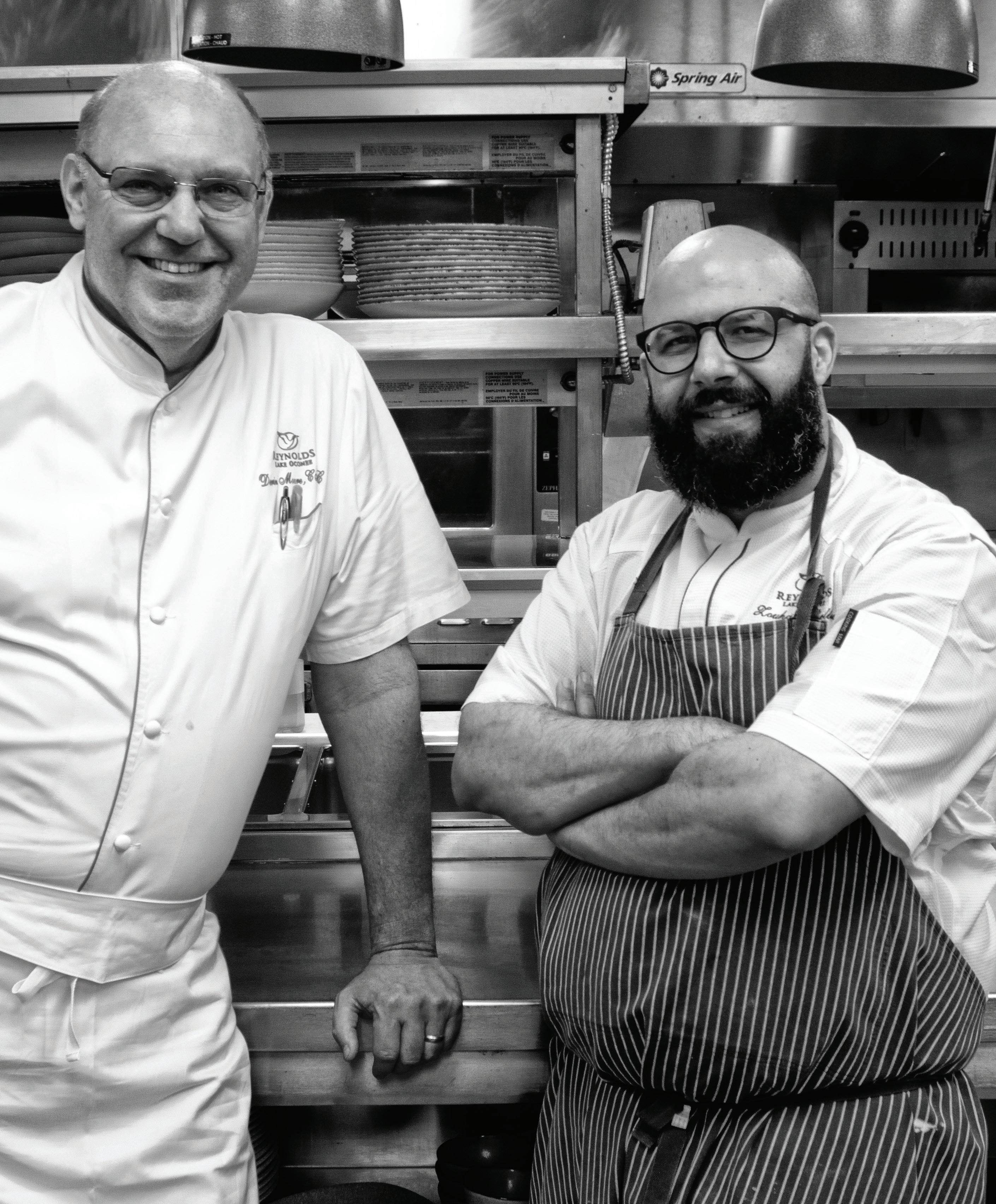
Reynolds Lake Oconee 19
but it was so cold in the winters and snowed way too much! I was not looking for a new position when I got a phone call from Lawrence McFadden, who at one time was the corporate chef for The Ritz-Carlton and transitioned to the Food & Beverage Director at The Ritz-Carlton, Naples.
Lawrence called me and said, “Hey, listen, you are familiar with five stars, five-diamond, and we’d love for you to come to talk to us about this job.” I said, “Lawrence, I’m running an operation with four food outlets and 45 culinarians, and you’re asking me to come to one with 20 outlets and 170 culinarians?” Regardless, I took the role.
GK: How did you land at Reynolds Lake Oconee?
It was 2012, and my wife and I got tired of moving around. It was fun during our twenties and thirties, but you know, we had three young kids who were starting to get older and had never grown roots anywhere. I was in and out in four or five years at several jobs because attractive offers at prestigious places kept presenting themselves. We’re bringing our kids along, but we realized that they hadn’t had a chance to develop friends and relationships. We decided to pick a part of the country, and then I’ll focus on finding a job there. We liked the Georgia area from when we lived here when I was at Dunwoody Country Club. We moved back to the area, and then the opportunity came up at Reynolds Lake Oconee. The kids were

Golf Kitchen Magazine 20
“ Everybody was competing in cold food competitions, and you’d get critiqued by Ferdinand Metz, Tim Ryan, and Mark Erickson. That was a precious experience, and it was fun to win gold medals. ”

Reynolds Lake Oconee 21
starting college, so it was good timing to make one more move.
In our business as chefs, you don’t get to sit in the big jobs and the rewarding careers unless you’ve gained that experience. You can’t manage larger kitchens and multi-facet operations without an extensive background.
Reynolds offers a multitude of opportunities and is in a great location. You’re in the mountains in two hours, and you’re down on the beach in four hours. We are right in the middle of everything and can easily get to anywhere in the world from Atlanta Hartsfield-Jackson Airport just down the road. When I got here, we had several clubhouses, but they were all very similar traditional menus. When you look at how the property is laid out, there was no reason for members to navigate to one of the other clubhouses; they just stayed with the clubhouse nearest to their home. That was one thing that I noticed when I started in July of 2015 here at Reynolds. When I assessed the membership needs, I wanted to define themes in restaurants with distinctly different menus and styles of dining. Doing this offers our members a unique dining experience from each of the restaurants across Reynolds. I also wanted to implement seasonal changes. We do three full property menu changes a year for all the restaurants, snack bars, and cafes. Fast forward five years, the members will ask us, “when are we getting another menu change?” We’ve gone through that whole cycle where the membership looks forward to it and expects it.
We opened The National Tavern, a hybrid of one of the restaurants I did in Naples called Bites. It was a tapas-sharing, casual concept that we created for the lobby. We put this concept together pretty quickly, from the menus to the china. This concept has become very popular at The Tavern, and pre-Covid, we were five deep at the bar and bustling every night.
GK: Are you busy when the Masters comes to Augusta National?
April is the start of the season, and the Masters takes place just about an hour down the road at Augusta National. Folks come to stay here and go down to the tournaments daily. Every house and room is booked.
GK: Tell us about the restoration that Jack Nicklaus recently did at Great Waters.
Jack Nicklaus oversaw a total restoration of the Great Waters course, which reopened in the fall of 2019. At Great Waters, we have The Overlook Restaurant and the Waterview Pub with a bar, indoor and outdoor seating, and a full kitchen. Both offer great views of the lake, and I like to keep the pub golfer friendly with casual pub fare.
It took me a little while to determine what menu items appealed to our members when I started. Most of our members travel and eat in high-end fine dining restaurants, so I had to balance that level of expectation and find menus that appeal to our members every day. In the end, it’s their club, and my job is to keep them happy by offering a selection of menus to give them different experiences to enjoy.
GK: What do your peers say when they visit you at Reynolds?
When I have colleagues come in, they say, “Man, you have everything from chicken fingers all the way up to luxury fine dining menus?” My reply, “I now have ten different dining locations to make that happen!”
Golf Kitchen Magazine 22
“In our business as chefs, you don’t get to sit in the big jobs and the rewarding careers unless you’ve gained that experience. You can’t manage larger kitchens and multifacet operations without an extensive background.”
GK: Tell us a little about Chef Zouhair Bellout at The Creek Club at Reynolds?
I enjoy working with him, all I have to do is poke him a couple of times, and then he wants to brainstorm. We come up with items that sell, what doesn’t sell, what’s working, and what’s not working. Many of our chefs are from different cultures or have traveled to many countries, so we can bring those influences to create our menus here. It is gratifying. Chef Zouhair is from Morocco, so once a month, we run a traditional tagine special for the members, which is going very well. Zouhair loves to go to the markets on his day off. He brings back the most incredible produce locally and worldwide to integrate into his specials.
GK: What are your plans at Reynolds Lake Oconee in the next few years?

We’re opening up new areas of development, and we’re continuing to see a great demographic mix of people move to the lake with a trend of younger buyers, especially with expanding work-from-home opportunities. We have a great variety of community members from different backgrounds and ages, which gives us so much freedom to create menus and events for all age ranges—from the grandparents, grandkids, young families, celebrities, and professionals.
GK: What new and current events do you have in 2021? Are you excited, and why?
Events, for the most part, are still on hold for 2021 due to Covid. One program that we have started over the last few months has become very popular for members is our meal kits. Every 2-3 weeks, I’ll offer a meal kit for two and shoot a video on preparing the meal. The kits include all ingredients portioned out for the meal, and I demonstrate how to prepare the meal from start to finish, including a select wine pairing from one of our sommeliers.
RECIPES BY DERIN MOORE, CMC
Prime Beef Tartare with Crispy Potato Pave, Statesboro Blue Cream, Thyme and Black Truffle
Serves 4
Ingredients
Prime Beef Tartare
• 12 ounces Prime Beef Tenderloin
• 2 Tablespoons Extra Virgin Olive Oil
• 1 teaspoon Fresh Thyme
• 1 Tablespoon Capers
• 2 Tablespoons Shallots (minced)
• 1/4 teaspoon Garlic
• 2 teaspoons Grain Mustard
• 2 sprigs Thyme (picked and rough chopped)
• 1 Anchovy Fillet (minced)
• Salt and Pepper (to taste)
Potato Pave
• 2 Russet Potatoes (peeled)
• 2 Tablespoons Olive Oil
• 1/4 cup Grated Parmesan Cheese
• 1 cup Duck Fat
• Salt and White Pepper (to taste)
Statesboro Blue Cheese Cream
• 1/4 cup Crème Fraiche
• 2 ounces Statesboro Blue Cheese
• 1 teaspoon Worcestershire Sauce
• Splash Tabasco
Garnish
• 1 ounce Black Truffles



• 3 sprigs Thyme (picked)
• Maldon Sea Salt
• 1 Tablespoon White Truffle Oil
Preparation
Prime Beef Tartare
Small dice the tenderloin and reserve over a bowl of ice. Combine all of the remaining ingredients and gently fold together. Chef Note: Do not over mix.
Potato Pave
Shave the potatoes as fine as possible on a Japanese mandolin. Toss with the olive oil to evenly coat. Line a shallow pan with parchment paper. Layer the potatoes while gently seasoning with salt, pepper, and parmesan cheese on each layer.
Top with parchment paper then cover with foil and bake at 300°F until tender through.
Press with another pan to cool overnight.
Cut into desired portions approximately 3”x 1”. Preheat a Teflon pan and add enough duck fat to cover the bottom. Brown the potatoes on all sides. Reserve at room temperature.
Statesboro Blue Cheese Cream
Gently mix all ingredients then purée in a Robot Coupe, and push through a tamis.
Assembly

Place the pave on the plate, top with about 3 ounces of the steak tartare.
Drizzle with the blue cheese cream.
Shave the truffles over the top and balance on top of the beef.
Finish with the sea salt.
Drizzle with truffle oil. Garnish with the picked thyme.
Wine Match
2015 Vietti Barolo Castiglione
Reynolds Lake Oconee 27
Paired by Steve Pinheiro, Restaurant Manager at The Creek Club.
The National Tavern Bar.
Image courtesy Reynolds Lake Oconee.
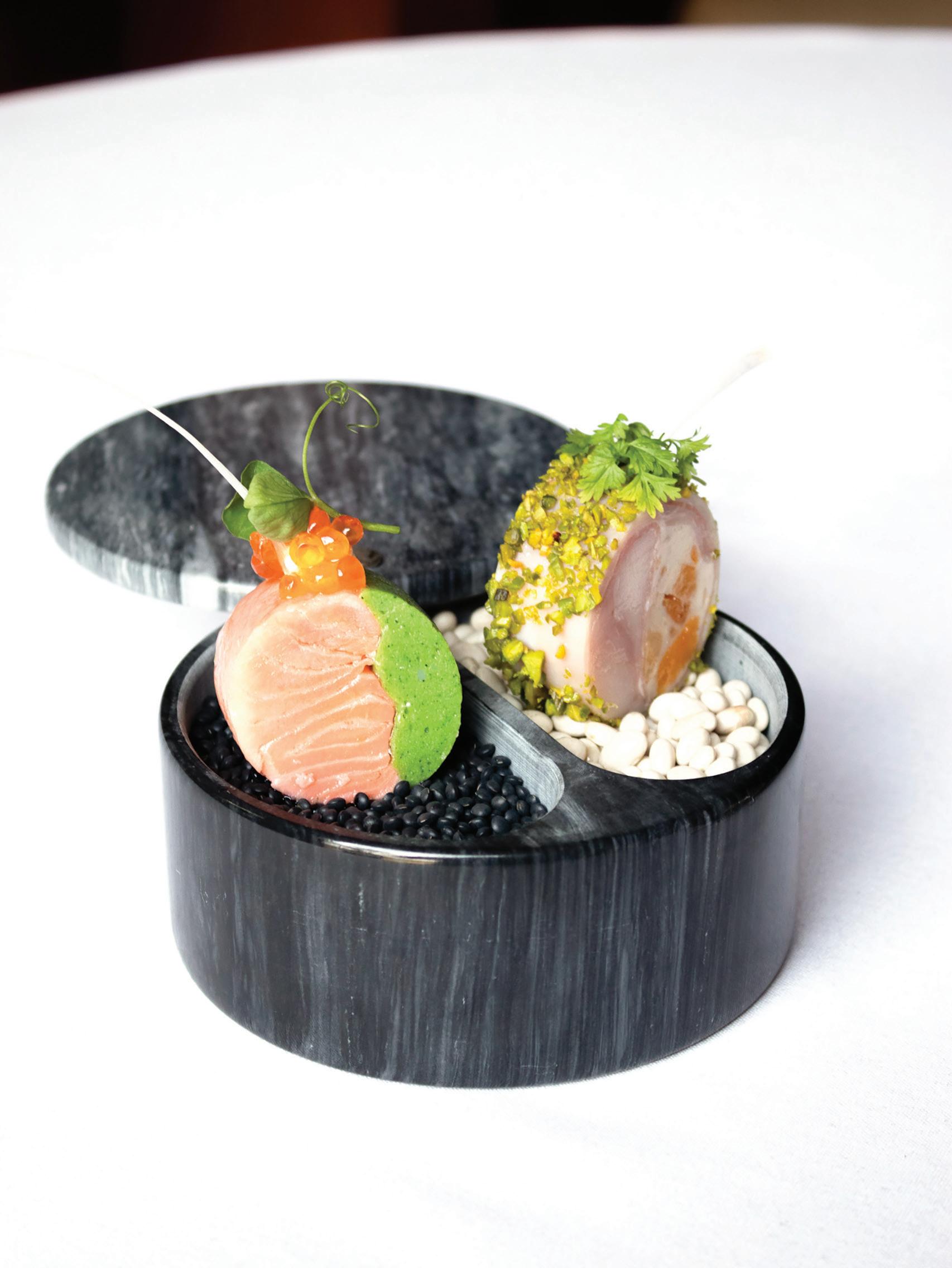
Two Chops Salmon with Chervil Mousse, and Preserved Lemon Cream Rabbit with Apricot, Prosciutto, and Pistachio
Serves 4
Ingredients
Salmon
• 1 whole Salmon (reserve four rib/belly bones)
Seafood Brine
• 2 cups Water
• 1/4 cup Sugar
• 2 Tablespoons Kosher Salt
• 3 White Peppercorns
• 2 sprigs of Thyme
• 2 sprigs Dill
• 1 Bay Leaf
• 1 teaspoon Coriander Seed
Chervil Mousse
• 8 ounces Scallops
• 1 teaspoon Dijon Mustard
• 1 teaspoon Lemon Juice
• Pinch Cayenne Pepper
• Pinch Old Bay
• 3/4 cup Heavy Whipping Cream
• 1/2 cup Chervil (loose pack)
• 1/2 cup Spinach (loose pack)
• Salt and White Pepper (to taste)
Preserved Lemon Cream
• 3 ounces Crème Fraiche
• 1 Tablespoon Lemon Juice and Zest
• Salt and White Pepper (to taste)
Rabbit, Apricot & Pistachio
• 1 Rabbit (boned out, save four rib bones)
• 6 slices of Prosciutto (very thin)
• 3/4 Dried Apricots (diced)
• 12 ounces of Leg Meat (boned out, ground fine)
• 1 Egg White
• Pinch Cardamon Seed (ground)
• Pinch Juniper Berry (ground)
• Pinch Star Anise (ground)
• 1 cup Heavy Whipping Cream
• 3/4 cup Pistachios (ground fine)
• Salt and White Pepper (to taste)
Garnish
• Salmon Roe
• Pea Shoots
• Chervil
Preparation
Brine
Combine the ingredients and bring to a simmer. Chill, then strain.
Salmon
Butcher the salmon and reserve four rib/belly bones, scrape and clean. Cut a 2” lengthwise filet about 8 inches long down the fat side of the fish. Brine for one hour. Pat dry. Allow to sit uncovered under refrigeration overnight. Gently poach the rib bones for two minutes and chill.
Chervil Mousse
In a chilled Robot Coupe bowl, process the scallops, spinach, chervil and the salt and pepper until tacky and very smooth. Add seasoning and gradually add the cream in a slow steady stream. Scrape down the sides, add the lemon juice and Dijon mustard. Process to incorporate.
Reynolds Lake Oconee 29
Salmon Roulade
Place the chervil mousse in a pastry bag and pipe an even bead of chervil mousse lengthwise on one side of the salmon fillet. Roll tight in Saran Wrap and poach in 150°F water to an internal temperature of 120°F. Chill.
Preserved Lemon Cream
Combine the ingredients in a mixing bowl, then set aside.
Rabbit, Apricot and Pistachio
Trim the belly of the rabbit down about 1” on each side to allow for a smaller roulade. Lay the boneless rabbit out on saran wrap. Remove one of the tenderloins and invert it over the other one. Making one long even tenderloin the length of the rabbit. Process the ground leg meat with the egg white and salt and pepper until very smooth. Add spices and gradually add the cream in a slow steady stream while the Robot Coupe is running. Fold in the apricots. Line the rabbit with the prosciutto. Pipe a bead of the apricot mousse down the center. Roll to close. Wrap tight in Saran Wrap. Poach at 150°F to an internal temperature of 145°F. Chill. Unwrap, roll in pistachios and rewrap tight. Poach the rib bones gently for two minutes and chill.
Assembly

Slice 1 1/2” chops out of each roulade. Gently insert the rib bones into each piece of the roulades. Place in a decorative fashion in the vessel of your choice. Pipe a small rosette of lemon cream on top of each salmon roulade and finish with the roe. Top each rabbit roulade with chervil.
Wine Match
2016 Goldeneye Pinot Noir, Anderson Valley
Golf Kitchen Magazine 30
~ Paired by Steve Pinheiro, Restaurant Manager at The Creek Club.
 The Landing #4 and #5.
Image by Evan Schiller, courtesy Reynolds Lake Oconee.
The Landing #4 and #5.
Image by Evan Schiller, courtesy Reynolds Lake Oconee.

SCALLOP and CLAM CHOWDER with Root Celery Cream, Smoked Bacon and Celery

Yields 4
Ingredients
Seafood
• 16 U-10 Scallops
• 20 Little Neck Clams
• 2 Tablespoons Olive Oil
• Salt and Pepper (to taste)
Root Celery Cream
• 1 Celery Root (approximately 3 cups roughly chopped)
• 4 ounces Slab Bacon (finely diced)
• 2 Tablespoons Shallots (minced)
• 1 teaspoon Garlic (minced)
• 2 cups Clam Stock
• 1 cup Heavy Cream
• 1 Bay Leaf
• 3 sprigs Fresh Thyme
• 2 Tablespoons Butter (chilled)
• Salt and White Pepper (to taste)
Celery Juice
• 2 cups Micro Celery
• 1/2 cup Olive Oil
• Pinch salt
Garnish
• Pearl Onions (peeled)
• Celery (peeled, bias cut, blanched)
• Bacon Lardoons
• Tri-Colored Marble Potatoes (cooked through)
• Micro Celery
Preparation
Seafood
Remove the adductor mussel from the scallops. Wash the clams then set aside.
Root Celery Cream
Render the bacon without color. Remove and reserve the bacon for plate up. Separate the shallots and garlic. Add the remaining ingredients and simmer until the celery root is very tender. Blend with the cold butter until smooth and strain. Reserve warm.
Celery Juice
Blend the micro celery with olive oil until very smooth. Allow to strain through triple layers of cheesecloth.
Assembly
Preheat a sauté pan, heat the olive oil, season, and sear the scallops.
Place the celery root cream in a shallow pan and simmer. Add the potatoes and clams and cover until clams are steamed open. Place five clams and three scallops into a shallow plate and garnish with the bacon, onions, celery, potatoes, and micro celery.
Wine Match
2018 Peju Sauvignon Blanc, Napa Valley

Golf Kitchen Magazine 34
~ Paired by Steve Pinheiro, Restaurant Manager at The Creek Club
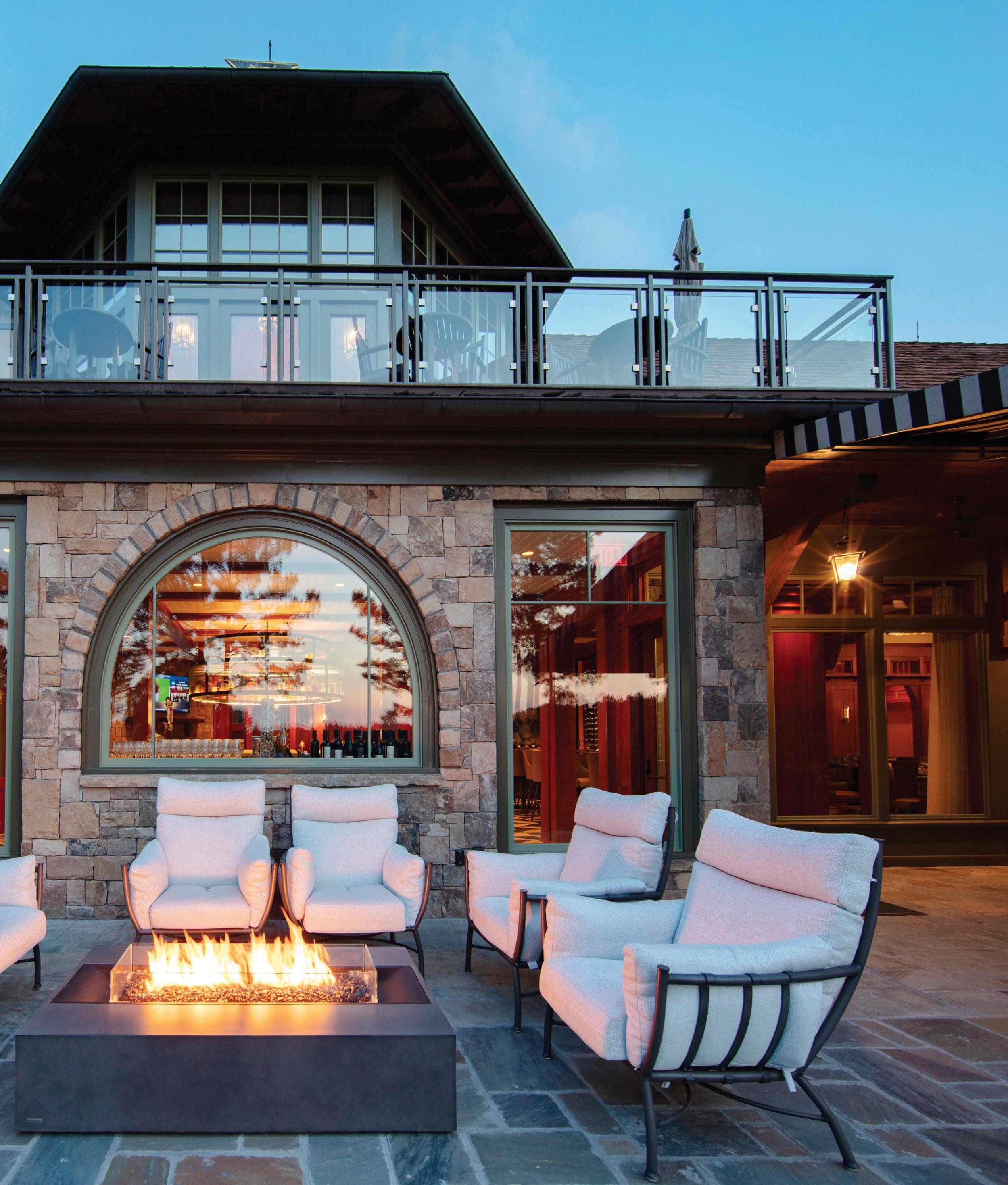
Reynolds
Oconee 35
Lake
The Creek Club patio.
Image courtesy Reynolds Lake Oconee.
Liver Mousse with Everything Spice Cracker, Radish, Port Wine Gelée and Arugula
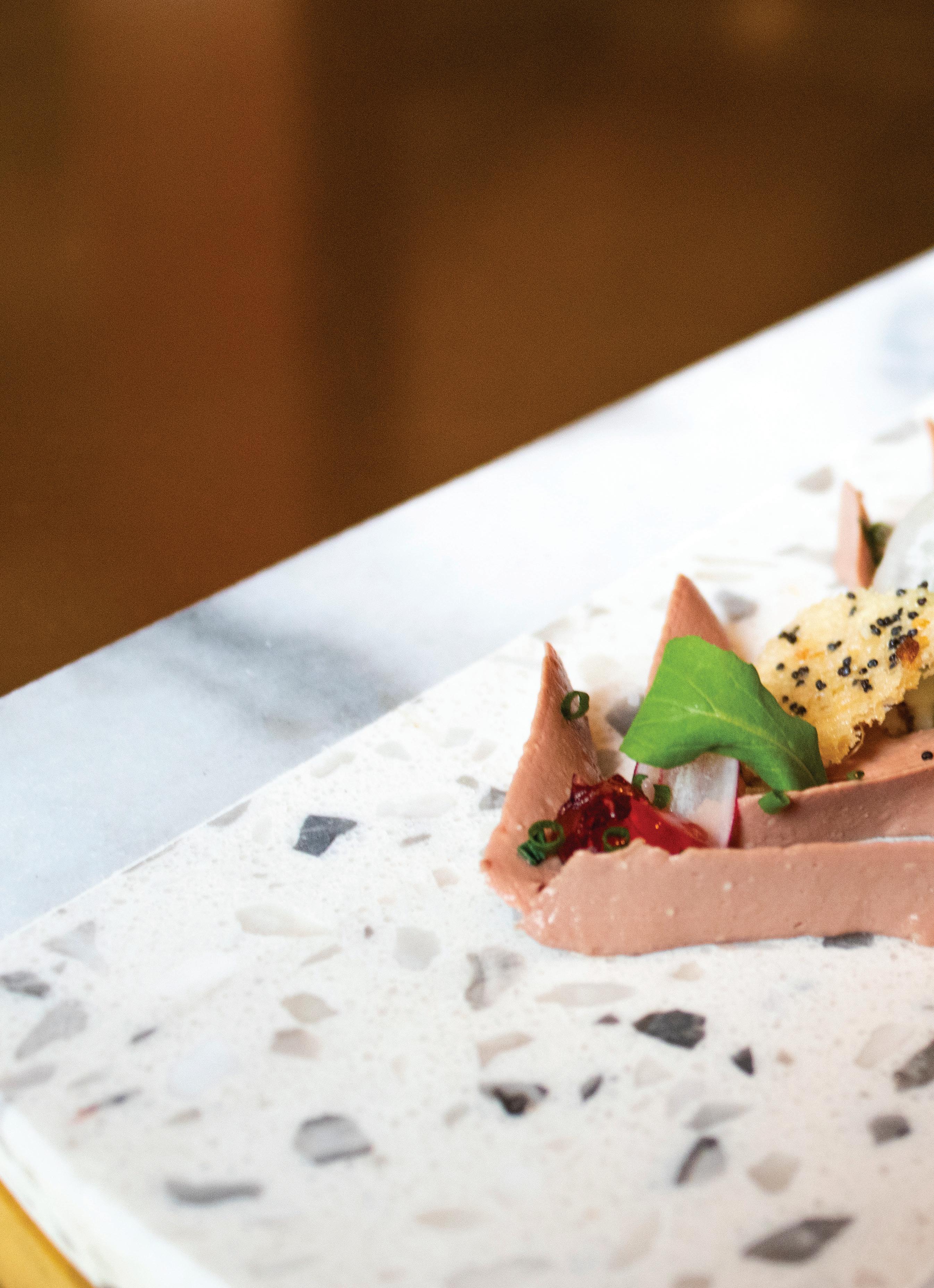
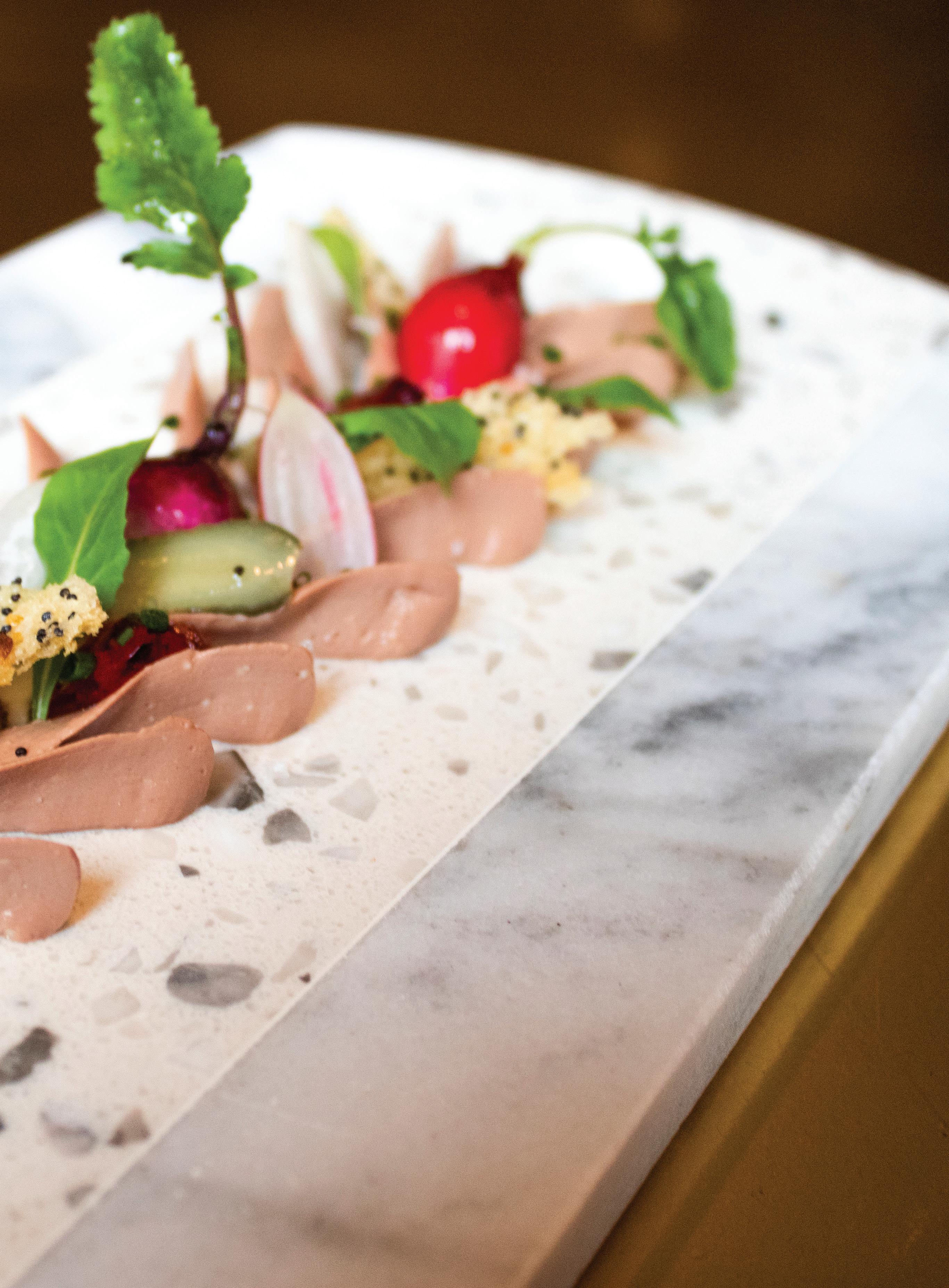
Serves 4
Ingredients
Livers
• 1 pound Chicken Livers
• 2 cups Milk
• 2 Tablespoons Brandy
• 1 Tablespoon Kosher Salt
Liver Mousse
• Cleaned Livers (see recipe above)
• 2 teaspoons Olive Oil
• 1 ounce Bacon
• 1 teaspoon Garlic
• 2 Tablespoons Shallots
• 2 Tablespoons Brandy
• 3 ounces Butter (whipped)
• Pinch Cayenne Pepper
• Pinch Cardamom Seed
• Pinch Cloves
• Pinch Ground Juniper Berry
• Salt and Pepper (to taste)
Everything Spice Cracker
• 4 thin slices of Brioche Pullman Loaf
• 1 Tablespoon Everything Bagel Spice
• Olive Oil
Port Wine Gelee
• 2 cups Port Wine
• 3 sheets Gelatin (soak to soften)
Garnish
• Baby Heirloom Radish
• Cornichon
• Micro arugula
• Chives (minced)
Preparation
Livers
Cover the livers and soak overnight in the regridgerator.
Liver Mousse
Pull the veins out of the livers. Heat the olive oil and gently sear the livers, cooking them all the way. Remove and chill. Render the bacon without color, flame with the brandy, and reduce to au sec (nearly dry). Combine all with the livers and chill completely. Process until very smooth in Vitamix. Push through a tamis. Gently fold in the whipped butter and adjust seasoning.
Everything Spice Cracker
Slice the brioche paper thin and brush lightly with oil. Sprinkle with the spice. Bake at 325°F until crisp and golden.
Port Wine Gelée
Warm the port and add the sheets of gelatin. Pour into a shallow pan and allow to fully set. Remove and rough chop.
Assembly
Pipe the liver mousse in a decorative fashion on the plate. Arrange the garnish in between the piping.
Wine Match
2013 Grgich Hills “Violetta” Late Harvest, Napa Valley
Golf Kitchen Magazine 38
~ Paired by Steve Pinheiro, Restaurant Manager at The Creek Club.

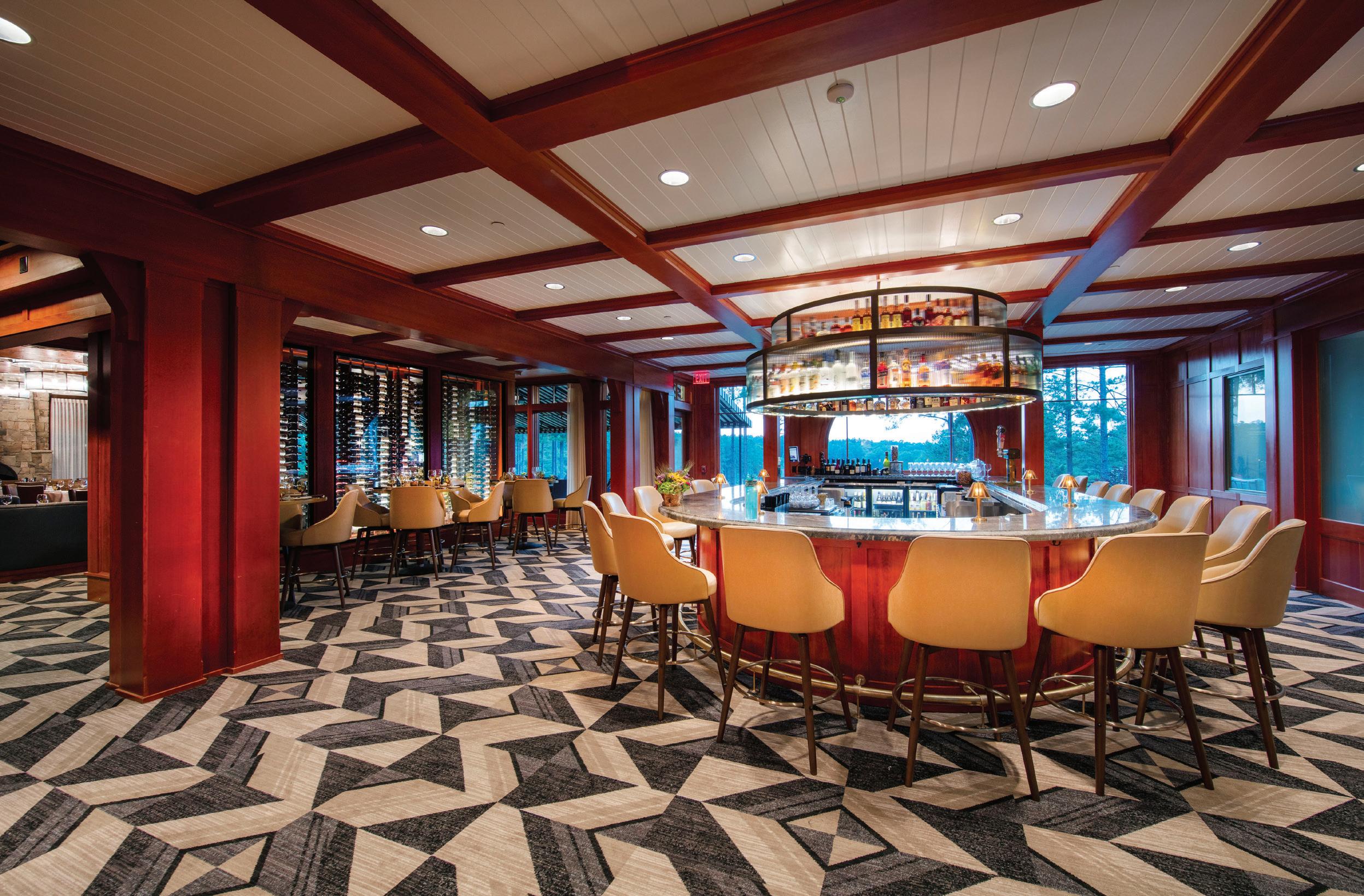 The bar at The Creek Club.
Image courtesy Reynolds Lake Oconee.
The Creek Club dining room.
Image courtesy Reynolds Lake Oconee.
The bar at The Creek Club.
Image courtesy Reynolds Lake Oconee.
The Creek Club dining room.
Image courtesy Reynolds Lake Oconee.
Smoked Beet Salad with Blood Orange, Fennel, Harissa Yogurt, and Petit Arugula


Serves 4
Ingredients
Smoked Beets
• 4 Yellow Beets
• 2 Tablespoons Olive Oil
• Salt and Pepper (to taste)
Harissa Yogurt
• 1 1/2 Cups Greek Yogurt (drained in cheesecloth overnight)
• 2 teaspoons Harissa
• 1 Tablespoon Lemon Juice
• Salt and White Pepper (to taste)
Blood Orange Vinaigrette
• 2 Blood Oranges (juice and zest, reserve segments)
• 1 Tablespoon Orange Blossom Honey
• 1 Tablespoon Champagne Vinegar
• 1/4 cup Olive Oil
• Salt and White Pepper (to taste)
Fennel
• 1 Fennel Bulb (thinly sliced)
• 1/4 cup Water
• 1/4 cup Pernod
• 1/2 cup Sugar
• Pinch Kosher Salt
Garnish
• Blood Orange Segments
• Pistachios (crumbled)
• Baby Arugula Leaves
• Beet Shoots
• Fennel Pollen
Preparation
Smoked Beets
Pre-heat the oven to 325°F. Rub the beets with the olive oil and season. Place in a shallow pan and cover. Roast until fork tender. Cool covered overnight. Peel and cut into desired shape.
Harissa Yogurt
Combine ingredients in a mixing bowl. Set aside.
Fennel
In a mixing bowl, combine the sugar, Pernod and water, simmer and then chill. Split the fennel in half and slice thin on a Japanese mandolin keeping the root intact. Dip the slices in the syrup. Drain and carefully lay flat in a dehydrator, dry until crispy, approximately 4 hours.
Blood Orange Vinaigrette
In a small mixing bowl, combine all of the ingredients except for the segments.
Assembly
Pipe the yogurt in a circular pattern on a plate. Decoratively arrange the ingredients around the yogurt. Finish with a light dusting of harissa, pistachios and fennel pollen. Place a smoking cloche over the top of the plate, fill the chamber with the smoking gun, and allow to sit for a few minutes. Remove the cloche tableside.
Wine Match
2019 Cloudy Bay Sauvignon Blanc, New Zealand
~ Paired by Steve Pinheiro, Restaurant Manager at The Creek Club
Golf Kitchen Magazine 42


The 5th tee at The Creek Club.
Image by Brian Oar, courtesy Reynolds Lake Oconee.
The 8th green at The National Cove.
Image by Brian Oar, courtesy Reynolds Lake Oconee.
Asian Pork Barbeque with Chili Sauce, Jasmine Rice, Cauliflower Kimchi, and Sprouts Salad


Serves 4
Ingredients
Pork Chops
• 4 Bone Pork Rack (remove the two center bones)
• 1/4 cup Togarashi Spice
• 2 Tablespoons Sesame Oil
• Salt and Pepper (to taste)
Chili Sauce
• 1 Tablespoon Sesame Oil
• 1 teaspoon Ginger (grated)
• 2 Tablespoons Green Onion (minced)
• 1 teaspoon Garlic (minced)
• 1 cup Hoisin Sauce
• 1/4 cup Cilantro
• 2 cups Chicken Stock
• 1 dry Red Chili
• 1 Tablespoon Fish Sauce
Jasmine Rice
• 1 1/2 cups Jasmine Rice
• 2 cups Water
Sprouts Salad
• 2 cups Mung Bean Sprouts
• 1/4 cups Thai Basil (hand torn)
• 1/4 cup Cilantro Leaves (freshly picked)
• 1/4 cup Mint (hand torn)
Cauliflower Kimchi
Chef Note: Make 3-4 days in advance.
• 1 head Cauliflower (cut into small pieces)
• 1 pound Napa Cabbage (cored and cut into 1-inch pieces)
• 1/4 cup Sea Salt
• 2 cups Daikon Radish (cut into matchstick strips - optional, or use carrots)
• 1 bunch Scallions (trimmed and cut into 1-inch pieces)
• 1 Tablespoon Fresh Ginger (sliced)
• 6 cloves Garlic (whole)
• 1 Shallot (quartered - optional)
• 2–6 Tablespoons Korean-style Red Pepper Flakes (Gochugaru)
• 2 Tablespoons Fish Sauce
• 2 teaspoons Sugar
Garnish
• 4 Lime Wedges
• 1/4 cup Peanuts
Preparation
Pork Chops
Preheat a sauté pan with the sesame oil. Sear the pork rack on all sides. Roast at 375°F to an internal temperature of 140°F. Half way through the cooking process, brush the loin with the barbecue sauce and roll in theTogarashi spice. Return and finish cooking. Allow to rest for about 10 minutes before slicing.
Chili Sauce
In a non-reactive sauce pot, heat the sesame oil and sweat the ginger, garlic and green onion without color. Add remaining ingredients and simmer for 30 minutes, strain and reserve warm.
Jasmine Rice
Place the rice and water in a rice cooker and steam until fully cooked. Fluff and reserve warm.
Cauliflower Kimchi
Cut the cabbage and place it in a large bowl with the salt and toss. Add enough cool water to cover the cabbage and stir until salt is dissolved. Keep the cabbage submerged with a plate over the bowl and let stand at room temperature 6 to 8 hours.
Drain the cabbage, saving the brine. Rinse the cabbage, squeeze out any excess water, and place it back in the bowl, adding the Daikon radish, cauliflower and scallions.
Make the PASTE: Place the ginger, garlic, shallot, red pepper flakes, fish sauce and sugar in a food processor. Process until well combined, pulsing, until it becomes a thick paste.
Scoop the paste over the cabbage and cauliflower using tongs or gloves, mix and massage the vegetables and the red pepper mixture together really well, until well coated. Pack the cabbage into a large, two-quart jar leaving 1 to 2 inches room at the top for juices to release. Add a little of the reserved brine to just cover the vegetables, pressing them down a bit (so they are submerged). Use a weight placed over top of the whole leaf to keep it submerged.
Cover loosely with a lid (allowing air to escape) and place the jar in a baking dish to collect any juices that may escape. Leave this somewhere dark and cool (55°F-65°F is ideal) for 3 days. A basement or lower cooler cabinet in the pantry or kitchen away from appliances works best. EVENING OF DAY 3: Check for fermentation action or bubbles. Tap the jar and see if tiny bubbles rise to the top. Check for overflow (which also indicates fermentation).
Golf Kitchen Magazine 46
If you see bubbles, it is ready to store in the refrigerator where it will continue to ferment and develop more flavor slowly. For a softer, tangier kimchi, you can continue to ferment for 3 more days or longer. If you don’t see bubbles when tapping the jar, it just may need a couple more daysespecially in cooler climates.
Sprouts Salad
Toss, serve raw.

Assembly
Place the rice, sprouts salad, sauce and kimchi in decorative vessels of your choice. Cut the rack in half. Thin slice each half toward the bone. Leave the bone standing up and fan out the sliced pork next to it. Garnish with lime.
Wine
Pairing: 2018 Trefethen Dry Riesling, Oak Knoll District of Napa Valley
~ Paired by Steve Pinheiro, Restaurant Manager at The Creek Club.
ClubsHelp Helps Clubs Support their Local Communities

What do Jack Nicklaus, Ernie Els, CLIF Bar & Company, Seminole Golf Club, and hundreds of other clubs around the country have in common? They’re all supporting causes in their local communities by working through ClubsHelp, a national movement that connects course owners, club managers, golf professionals, corporate partners, and others into a powerful network for doing good.
ClubsHelp, a 501(c)3 Foundation, works to maximize relationships between clubs and the charities that are most important to them. By providing clubs with valuable resources and access to a vast and powerful network resources, ClubsHelp furthers the value of clubs’ philanthropic efforts and contributions in times of crisis.
A Brief History:
The ClubsHelp Movement Began with One Club, and One Big Visio.n
It all began with sandwiches: The simple desire of Spring Brook Country Club, in Northern New Jersey, to donate sandwiches to frontline workers at nearby Morristown Medical Center (MMC) at the outset of the Covid-19 pandemic.
The challenge was gaining access to the right people. Spring Brook members got on their phones and computers, started networking, and made contact with someone at MMC. A relationship was born.
Sandwiches were just the beginning. Soon after, club members delivered six pickup-truckloads of Gatorade, soda, water, and food to the ER.
These efforts caught the eye of a Fox News executive, who thought the story was perfect for the network’s “America Together” segment on the Fox & Friends morning show. Last April, Spring Brook’s General Manager and COO, David Bachman, talked on air about how his club was supporting frontline workers.
Suddenly, a local story was in the national spotlight, where it got the attention of Rob Goulet, CEO of Entertainment Sport Partners, Inc., and manager to World Golf Hall of Famer, professional golfer Ernie Els. A few hours after Bachman appeared on TV, he received a call from Goulet. “Rob says, ‘Hey, I saw what you’re doing. What do you think about growing this nationally?’” recalled Bachman. “I was like, ‘Wow, sure. How do we do that?”
Step one was getting other local clubs involved. Bachman, a member of the New Jersey Chapter of the Club Management Association of America (CMAA), made a few calls and learned that Mount Sinai Hospital in New York City was in desperate need of supplies. He called John Dorman, General Manager at The University Club in New York and secured his support for Mount Sinai. He also connected Deepdale Golf Club on Long Island with Elmhurst Hospital in Queens.
Golf Kitchen Magazine 48
Goulet was also burning up the phone lines. Securing the support of Els to back ClubsHelp, he was able to get him to appear with Bachman on Fox & Friends for a second time. Els also wrote a letter to the board at famed Seminole Golf Club, where he’s a member, resulting in a contribution of $285,000 from the club to Jupiter Medical Center in Florida.
Goulet also persuaded Turner Broadcasting to earmark some of the millions raised by Capital One’s “The Match: Champions for Charity”— which featured NFL legends Tom Brady and Peyton Manning playing with golf icons Tiger Woods and Phil Mickelson at Seminole—to ClubsHelp.
Further endorsements came from 18-time major champion Jack Nicklaus and former LPGA golfer Kris Tschetter, another Goulet client. He also reached out to Gary Erickson, owner and founder of Clif Bar & Company, who donated some 10 million CLIFBars to front-line healthcare workers around the country.
“I started calling people I knew were influencers and saying, ‘Hey, we’re putting this band together and we would love to get your help,’” said Goulet. Several large club-management companies agreed, including Concert Golf Partners, ClubCorp, Arcis Golf, and Dormie Network. In just two weeks, ClubsHelp was supported by nearly 300 clubs nationwide.
Over time and with more clubs and others signing on, it became increasingly evident to Bachman and the other members of the newly created board that ClubsHelp, “wasn’t just a response to COVID-19.” It had become a national network of clubs committed to supporting many different causes and charities in their local communities, especially in times of need or crisis.
ClubsHelp adopted a motto—“Care Locally. Unite Nationally.” Which is exactly what it’s doing. “We’re just a giant network of helping,” said Bachman.
Get Your Club Involved
Through ClubsHelp, clubs receive support to maximize their philanthropy and increase their ability to provide local aid and resources. An on-line fundraising platform helps clubs quickly and effectively raise funds and awareness.

With so many charity golf tournaments being canceled due to the pandemic, we created an event that adheres to social distancing protocols. The ClubsHelp 100-Hole Challenge allows members and sponsors to support players who are raising money for local charities. It’s a winning proposition.

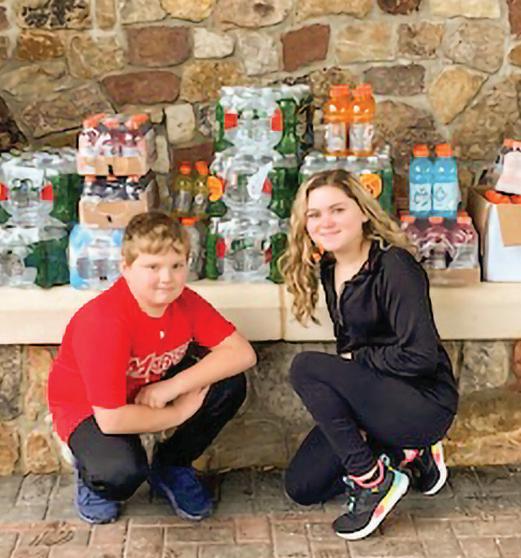
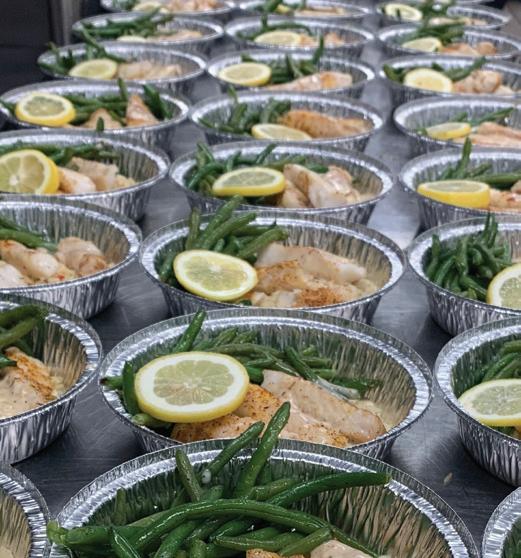

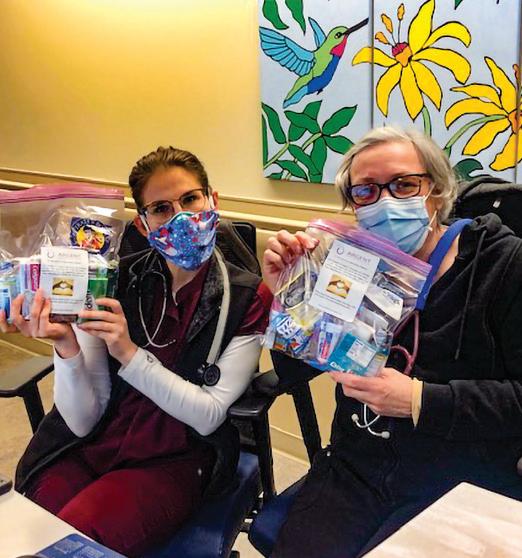


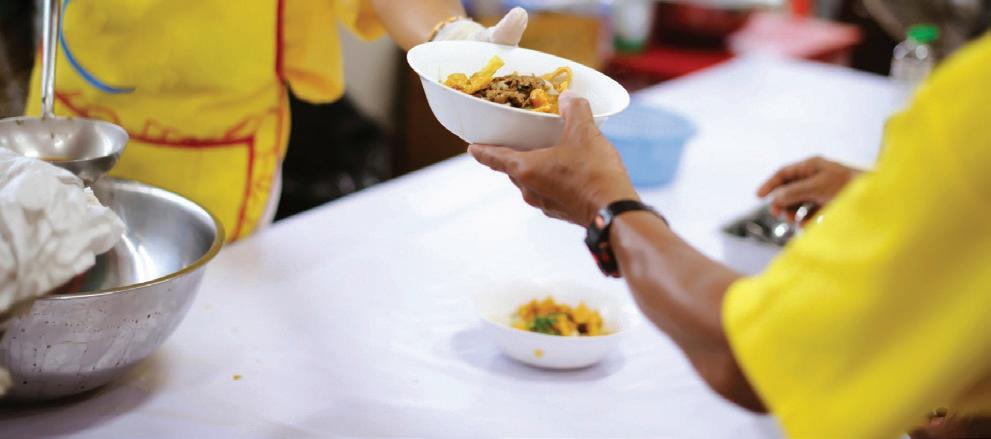

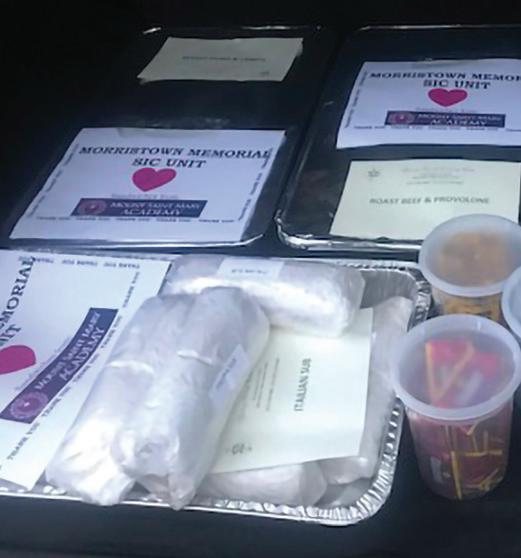



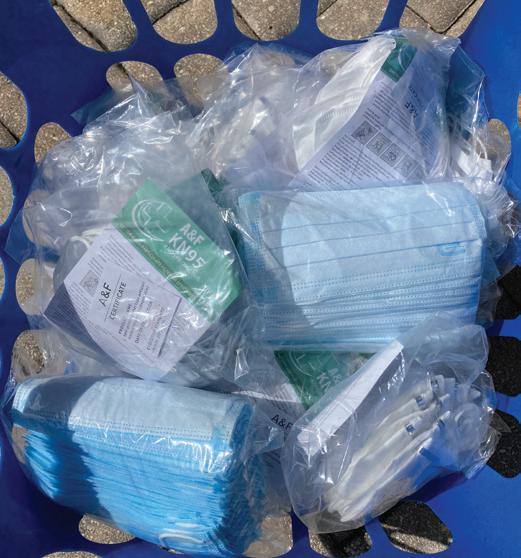

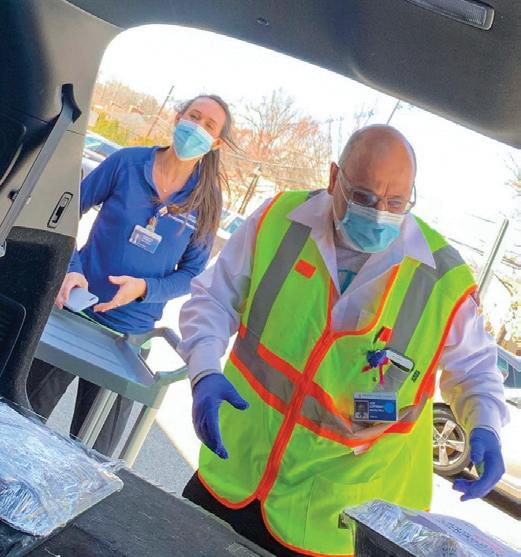 Michael McCarthy, CEO, Addison Reserve Country Club
Michael McCarthy, CEO, Addison Reserve Country Club
Golf Kitchen Magazine 50
Connecting golf clubs with local hospitals, food banks, emergency services responders and nursing homes in
local communities to aid in
COVID-19 crisis and beyond...
Enroll your club today at clubshelp.org
their
the
Join The Movement...
At the present time, ClubsHelp offers three event opportunities:
ClubsHelp’s 100-Hole Challenge
It’s a fundraiser, it’s a marathon, it’s a way to give back to local communities—all through golf. The ClubsHelp 100-Challenge raises funds for local charities nationwide.
Amateur golfers, including club staff or teams from local charities (typically in groups of 2 or 3), choose a day to play 100 holes of golf from sun-up to sundown to raise money.

Member clubs receive promotional support from ClubsHelp, including a pledge app, national leaderboard, and promotional tool kit.
Golf Kitchen Wine Dinners presented on behalf of ClubsHelp
Memorable evenings begin with a wine tasting, followed by an expertly prepared dinner with wine pairings to enhance the experience. The evening concludes with après dinner drinks and a live auction with unique items available for bid.
This series of exclusive wine dinners, to be held at prestigious golf clubs throughout the United States, raises money for local causes important to each club through the resources of ClubsHelp.
The ClubsHelp Scramble
This scramble fundraising event starts at the club level and progresses to regional, and eventually national finals. Four-person teams compete, according to their handicaps, with proceeds supporting local charities each step of the way.
Editorial by Karen Moraghan
Karen is a founding board member of ClubsHelp and president of Hunter Public Relations (www. hunter-pr.com), a respected media relations and special events firm, with bi-coastal offices and a stellar reputation for promoting the upscale golf lifestyle.
GlenArbor Golf Club
Traditions in Wine Excellence Award with Fernando Silva

I was fortunate to attend the previous two “GlenArbor Traditions in Wine Excellence Award” events in Bedford Hills, New York. Fernando Silva, Sommelier, Michael Ruggiero, Executive Chef, and team seamlessly delivered an unforgettable experience to the club’s members and guests. I believe that this significant annual event will be a gamechanger in the private golf and wine industry. ~ Diana
DeLucia
GK: Fernando, how and when did the vision for the “GlenArbor Traditions in Wine Excellence Award” come about?

GlenArbor Golf Club was inaugurated in 2001, and I joined the team in 2005. At that time, a wine program did not exist. The food and beverage manager selected some of the wines, and I remember that the members would bring numerous bottles of expensive wines from their private cellars to enjoy at the club.
I developed an interest in fine wine in 2009 and started reading and studying wines seriously in the following years. I signed up for every seminar and wine tasting I could find in Manhattan. This process and exposure to wine tastings and in-depth study of the wine world changed my approach to the fine dining experience. Every weekend I waited to see the wines the members would bring to dinner. I used to take pictures of the labels and researched the places of origin and the quality levels. All of that effort paid off and the
“Fernando is a quintessential wine professional, and it is rare to find someone as accomplished. He is a leading light in wine expertise in the private golf club industry.
GlenArbor Golf Club and its team of professionals have the industry accolades to give authority to this very prestigious and worthy award. It is a tremendous honor for the recipient and speaks loudly for their passion for the traditions of wine, the respect of nature, the land, and the game of golf.
The Traditions in Wine Excellence Award, I believe, will become a legacy award that will continue well into the future.”
Adam Strum CEO/Owner Wine Enthusiast
members noticed. The food and beverage director at the time, Bryan Smithwick, promoted me to be the official Sommelier at the club. Mr. Grant Gregory, the owner, gave me enough freedom to experiment and launch a series of wine tastings, which would take place at the end of every golf tournament to test our membership’s enthusiasm. The response was excellent; they wanted more and more wine experiences.
In 2011, I had to leave the USA for a year to wait for my green card approval. I decided to take a long-awaited wine field trip to discover and learn about the most famous wine regions. I traveled to Germany, Austria, Switzerland and then returned to Argentina to visit Mendoza’s vineyards.
In 2012, I returned to the USA and visited the Napa Valley in California. When I arrived back in New York, I simultaneously registered for the prestigious Court of Master Sommeliers and the American Sommelier Association. After much work and study, I obtained the proper certifications.
GK: When and how did you introduce an official wine program at the club?
2013 was a period of test and trial. By 2014 the idea of
Fernando Silva
Image by Michael J. Fiedler
a serious wine program had begun to take form in my mind. I am also a passionate artist, and in the the same year, my work featured at a prestigious art gallery in Manhattan for the first time. I had overcome some serious challenges and gained much education and knowledge, which I could not have done without the mentoring and support of the Gregory family and GlenArbor. I wanted to show my gratitude to the people that believed the most in me. I researched other private clubs and some notable wine clubs in the city. I reached out to Mr. Laurent Drouhin, whom I met through my studies at several wine seminars. I took his advice and expertise to create a new concept in the wine experience at GlenArbor.
GK: How did Mr. Drouhin help you develop this program?
Mr. Drouhin suggested that I discuss creating an effective and more interactive wine program for the club. Mr. Grant Gregory gave me some practical ways to execute long-term plans. After meeting with him several times, at the end of the conversation, he asked me to write down forty different ideas about implementing a wine program even if the idea sounded crazy!
The following week I presented Mr. Grant Gregory
and Mr. Morgan Gregory at least 45 ways and strateegies to create, execute and enhance a wine program for private clubs. After reviewing the concepts and removing half of them, he instructed me to select five or six of my most robust visions, and to my delight, he gave me the freedom to try them out at the club.
GK: What were some of your final visions?
To create a unique new wine program, we needed to complete the first idea on the list, installing a state-ofthe-art wine cellar located on the second floor in our Players Lounge. I reached out to Mr. Adam Strum and his team at Wine Enthusiast Magazine, they helped us create the cellar, and it was complete by 2017.
The next step was to implement a marketing campaign among the members with a series of wine educational seminars to attract more attention not only from the members but also from wine aficionados in general.
I explained to Mr. Grant Gregory that we needed to create a series of awards to recognize the diverse personalities that impacted the wine world. Help came from Mr. Morgan Gregory with his true entrepreneur style; he came up with a name, mirroring the already existing “Traditions in Golf Awards.” The first “Traditions in Wine Excellence Award” was inaugurated in

Golf Kitchen Magazine 54
“Family and tradition are some of the core values of our passion for wines in Burgundy and Oregon. When Fernando Silva contacted me on behalf of the Gregory Family to receive the GlenArbor Traditions in Wine Excellence Award, I felt tremendously honored., not personally but in the name of the entire Drouhin family current and past generations. GlenArbor, Golf and wine is a paradise for tradition and passion...”
~ Laurent Drouhin Co-Owner
Maison Joseph Drouhin
2018. It was received with excellent attendance and created a pathway for more events at the club.
GK: How do you select the recipients?
The recipient of the “GlenArbor Traditions in Wine Excellence Award” does not necessarily have to be a winemaker. The main idea is to select from a group of well-known personalities in the wine industry that has an actual and long-term impact not only in the wine world but also in the hospitality industry, especially in the private club sector. Every recipient of the Award should have a strong respect for the hospitality industry, nature, the land, and the traditions of the game of golf. The Award is the perfect link between the World of Wine and the World of Golf!
GK: Who was the first recipient?
Our first recipient was Mr. Laurent Drouhin, co-owner of Maison Joseph Drouhin in Burgundy, France. Laurent currently resides near New York City. He manages the market’s development and the brand’s image in the United States and the Caribbean. He graduated from the Ecole Supérieure de Gestion in Paris.
The second recipient was Mr. Jean-Charles Boisset in 2019. He was born into the world of wine in the village of Vougeot, Burgundy, France. His lifelong passion for wine began as a child. He grew up above the cellars within the view of Château du Clos de Vougeot’s centuries-old vineyards, the epicenter and birthplace of Pinot Noir and Chardonnay. Mr. Adam Strum, President of Wine Enthusiast Magazine, attended the event with his wife and family and was thrilled that Jean-Charles was the recipient.

The third recipient was Sir Nick Faldo in 2020. I discovered Sir Nick’s serious wine projects while I was attending a blind wine tasting seminar in Soho. One of my mentors, Mr. Phillipe Newlin, at that time was the Director of Duclot la Vinicole in New York mentioned that he recently came across a famous Golfer at The Harvard Club in Manhattan, Sir Nick Faldo. After several meetings, Sir Nick invited him to review his wine projects.
I set my mind on inviting Sir Nick to be part of the the event, but due to the Covid-19 outbreak, that seemed impossible. The second option would be via video conferencing.
“Exhilarating, inspiring, magnetic and so enchanting ! A vortex of joy, happiness, and a true experience of the senses….
I feel honored and privileged to receive such recognition and to be part of such a fabulous and exciting collection of grand minds and energies ! Here’s to the rhythm of life and the swing of all senses in motion !”
~ Jean-Charles Boisset Vintner, Proprietor and Wine Entrepeneur
Thank you very much for this honor of Wine Person of the Year! I am beyond thrilled to receive something like this. If there were a Ryder Cup of wine, it would be Napa vs. Bordeaux, and I will be supporting the European team. I can assure you the playoffs will be really fun! I will be flying back to the United States soon, hopefully, and will have a wee glass to celebrate!
After exhaustive months of uncertainty and back and forth emails, I received a video acceptance speech from Sir Nick, which I shared with Mr. Morgan Gregory immediately.
A day after receiving the video from Sir Nick, former American football linebacker and Steelers coach William Laird Cowher came to the club for dinner with his wife, famous rock singer Veronica Stigeler.

Mr. Cowher is also a wine enthusiast and with the the proximity of the event, he enquired who was going to be the honoree this year. When I mentioned Sir Nick’s name, he reacted with a big smile saying, “Fernando, you know he is a good friend of mine, and it will be an honor for me to do the introduction and presentation of the Award.”

GK: How do you feel Covid-19 will affect the event in the future?
The year 2020 presented a real challenge for us with the strict enforcement of safety protocols in the hospitality industry. But it also set a new way of looking at the industry. As professionals, we have to adapt quickly to the changing times and demands of our membership. In our case, our wine events are planned according to the Center of Disease Control (CDC) safety regulations, including testing staff, wearing gloves and masks, social
~ Sir Nick Faldo
Michael Ruggiero, Executive Chef
Sir Nick Faldo accepts the GlenArbor Traditons of Wine Excellence Award via Zoom from Europe. Image by Michael J. Fiedler
distancing, frequent sanitation of workstations, dining, and limited clubhouse areas. We maintain the number of attendees for this and all other events to the minimum recommended by the government.
GK: How do you work with Chef Ruggiero to come up with the menu for the GlenArbor Traditions in Wine Excellence dinner?
Executive Chef Michael Ruggiero has an incredible resume and vast experience in fine cuisine. I begin by presenting Michael with the event’s theme and share my ideas while we taste the wines.
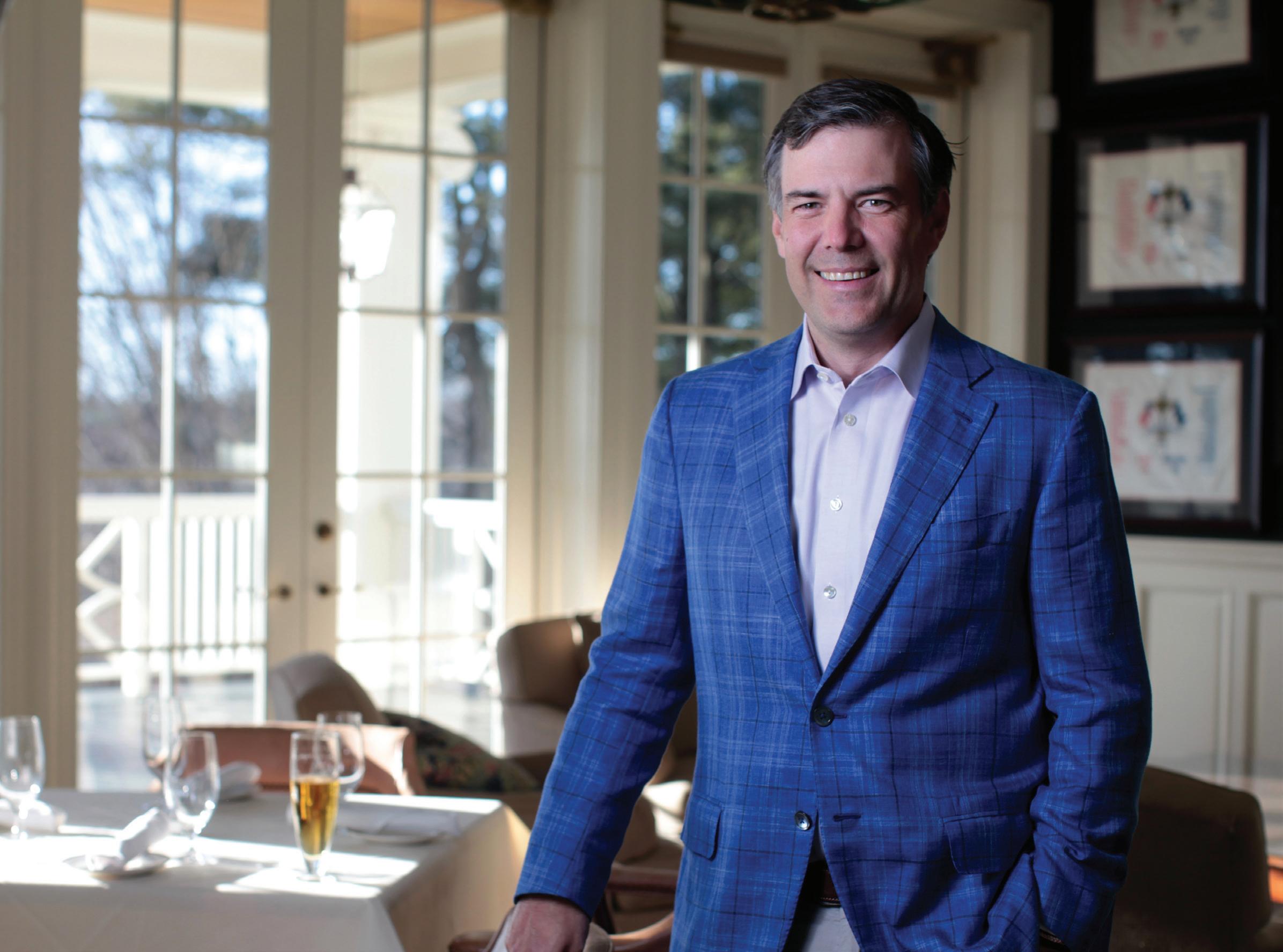
Every wine and honoree has a different personality, and it shows in the way they represent their terroir, their aromas, and flavors, Sometimes we need to change some of the wines because the actual profile does not match the envisioned dish; there is a lot of creativity involved in the process and also flexibility. Everything progresses, evolving to present the best culinary experience for the members, guests, and staff.
GlenArbor has always strived for excellence in multiple areas – golf, instruction, food, wine, and “the experience.”
We have been blessed to identify and celebrate the leading industry winemakers, families, and originators but, it’s a much bigger platform.’The Traditions in Wine Excellence Award’ celebration recognizes those individuals who excel in moving the needle, and those willing to create a platform, vision, and growth for the generations to follow.
~ Morgan Gregory President GlenArbor Golf Club
“When tasked to pair food with amazing wines for an event like this the process takes on a variety of factors, cuisine origin of the wine, seasonal ability of ingredients, presentation, among a few thoughts.
While the goal is to match flavors with each dish, I won’t let it restrict me from the goal of wanting to create this intense flavor profile. We have to honor the wine, attempt to rival each wines great finish but also not overpower the many delicate notes. We love these opportunities and these marquee events, we circle on the calendar because they only happen a few times a year.”
~ Michael Ruggiero Executive Chef GlenArbor Golf Club
Image by Michael J. Fiedler

Baltusrol Golf Club Springfield, New Jersey
 The Baltusrol Clubhouse
Image by Evan Schiller
The Baltusrol Clubhouse
Image by Evan Schiller
Ed Stone Executive Chef Baltusrol Golf Club
I have always had a robust interest in the history that surrounds private golf clubs. Baltusrol is no exception. Upon entering the Clubhouse, I was taken on a journey back in golf history. I was working with esteemed Executive Chef Ed Stone, and at the same time, mesmerized by the passion Baltusrol has for golf and preserving its heritage. I am proud that this story will become a part of that. ~ Diana
DeLucia
GK: Where did you grow up, and where did you get your first taste of kitchen life?
I was born in Nashville, Tennessee, to parents who had to move a lot as we were a military family; however, I have lived in New Jersey for most of my adult life. Wherever we lived, no matter what, we always made room for a garden to grow fresh fruit and vegetables and things of that nature. My earliest memories are of fresh Bibb lettuce, fresh corn, and green beans. My grandfather of my father’s side raised bees, so we always had honey. I can’t really say this inspired my career, but it was my introduction to fresh ingredients.
When I was in high school, many of my classmates worked in restaurants to make extra cash. I was 15 when I got my first job, and they used to leave the window cracked open for me to climb into early mornings so I could clean the restaurant before anyone arrived.
I worked through high school, and it became time to decide what I would do as a career. I liked working with my hands. I liked getting the immediate gratification of cooking. However, in the late seventies, early eighties, it was not considered a respectable career like it is today. My mother would cry and tell me that it was a job that people took if they didn’t go to college, but it did not dissuade me from pursuing a career in the kitchen.
I worked in local restaurants, and then when I
got serious about cooking as a career, I had the Culinary Institute of America (CIA) on my radar. It was 1980. When I started at the CIA, Ferdinand Metz was the President, and it was when we all had to wear white pants. Classes after ours switched to the checkered pants; that’s how we defined ourselves as the white pants guys. (laughs) It was not what it is today, but it got me started. There was a chef there that took a shine to me, Roland Henin, a French chef. He was probably one of the tougher instructors. He would make people cry. He would yell at you if you made Hollandaise sauce and it was too yellow. He caused quite the backup at the CIA as he failed so many people, and they would need to take classes a second time.
When I graduated, Christian Delouvrier, a renowned Master Chef from the Maurice in Manhattan, sent a contact to the CIA as he was looking for some young talent. Roland Henin recommended me, and that is how I got my first position out of culinary school.
Delouvrier was an excellent chef, he was older, and his restaurant Maurice was inside the Park Meridian Hotel in Manhattan. The pay was lousy back then, and we barely made $7.50 an hour. He was old-school French and did not have much respect for the American guys. One time he told me that I wasted my time and money going to culinary school! I spent about five and a half years working for him, and when I left, I was his executive sous chef.
GK: Were there any notable chefs working the line with you at the Maurice?
I worked the line with some excellent up-andcoming stars such as Ed Brown, who is now known from the Sea Grill in Rockefeller Center Throughout my time there, we had numerous guest chef appearances, such as Jean-Louis Palladin, Marc Haberlin, and Adolphe Bosser, to name a few. I was extremely fortunate to cook alongside those renowned chefs. I even
INTERVIEW Golf Kitchen Magazine 60

had the opportunity to train under Jean-Louis Palladin for about a year. I left there with solid knowledge, and I still stay in touch with my line team to this day.
GK: Where did you go after Maurice?
I took an Executive Chef position at the Grand Bay Hotel, which was across the road from Le Bernardin on 51st Street in Manhattan. It was a small boutique hotel, and Harry Cipriani had space below. It did not work out for me as they wanted to send me down to Coconut Grove, Florida. I did not want to be a corporate chef as they move you around at a moment’s notice. I was starting a family, and my wife, Ann, had family here in New Jersey. I left after a short period of time and secured a position at The Bernards Inn in New Jersey.
New Jersey, at that time, was not known for cuisine, but I still wanted to go. I heard about it through a friend, and I thought I would go check it out. The Bernards Inn was a boutique hotel in downtown Bernardsville. The owners were putting a lot of money towards renovations but were having trouble getting it up and running. Although it was a challenge coming out of a Manhattan restaurant, I took on the role.
When I first arrived at The Bernards Inn, the dining program had an unfavorable reputation. When I took over, I updated the cuisine to reflect my French training and blended it with American cuisine. We established an award-winning dining program and received various honors, including the Mobil Four-Star Award and the AAA Four Diamond Award. It was rewarding to see our hard work pay off and for the Inn to garner such well-earned acclaim. I was at The Bernards Inn for 15 years and had partial ownership.
GK: Tell us about the foundation you started while you were at The Bernards Inn.
In 1993, I started a charity foundation called Dinner of Hope with Chef Craig Sheldon, Chef Michael Schlow, and Diane Carr from the HobNob in Martha’s Vineyard. The foundation was raising money for children’s charities across the state. We would bring fine dining chefs such as Eric Ripert and other great chefs to cook a course each, and we would sell the
tickets. While I was president, we raised over $2 million for children in need. It was a lot of fun working with those guys, and in 2001, we handed over the reins to a foundation, Creative Heartworks.
GK: How did you land at Baltusrol Golf Club?
My partners at The Bernards Inn sold their shares in 2002, and I thought it was time for me to try something new. I needed to reinvent myself to keep things interesting. A member of The Bernards Inn staff, Judy Mann, was hired by Baltusrol as the catering director.
Judy knew that I was a little discontent with where I was, and she asked me to get my resume together and start applying for positions. I took her advice and started to explore possibilities. Judy had mentioned my name to Kevin Vitale, the General Manager at Baltusrol. He reached out to me, and even though I had never considered a golf club as an option, I went for an interview.
GK: How was the interview?
I will always remember that first interview with Kevin. He would finish my sentence, and I would finish his! We had and still have an excellent connection. I thought to myself that this is too good to be true.
I asked Kevin if he was sure the club was serious about making the changes I was hoping for. I was accustomed to ordering from The Chef’s Garden and other great purveyors. I knew I needed to hear this from the Executive
Golf Kitchen Magazine 62
”We established an award-winning dining program and received various honors, including the Mobil FourStar Award and the AAA Four Diamond Award”
Committee that they wanted to make changes in a real way. They were all very committed. That is how it came about. That was 2004, and after I accepted the position, I had one vendor tell me I was committing career suicide by coming to a private club! I went with my gut this time. Kevin is really a big part of why I am here.
GK: This is an impressive place from my perspective, the amount of golf memorabilia here and the history, the art is just astounding.
I was impressed. At the time, the club was going through a transformation. It was beautiful, but you could see things needed to be updated. Especially the kitchen, it was tired. (chuckles) Kevin had told me that they were planning a kitchen renovation, and I am so thankful they did as I would not have been happy long term in the condition that it was in at that time.
GK: So how long did that renovation take?
I started working here in May 2004, and we started the kitchen renovation on January 2nd, 2005; and we got it done before the PGA event that same year! It was a big year, that is for sure.
GK: In 2004 and 2005, that was about the time when the Food Network became popular. Chefs were becoming their own brand, and fine dining was trendy. How did that reflect on the membership?
Our members are world travelers, and they would have eaten at some of the finest restaurants in the world, so I could not understand why the cuisine at the club was not held to a higher standard. It was my goal to change that.
GK: Tell us about Mr. Jim Davies.
Jim Davies is a member and a real foodie, and a genuinely nice man. He was a member of Confrérie des Chevaliers du Tastevin in in New York, and they would have dinners and tasting menus with great wines at The Sea Grill, Le Bernardin, and Perse in Manhattan. Mr. Davies was incredibly supportive and requested I do a tasting menu at the club. He wanted to allow me to express myself creatively with a dinner. He was a big supporter.
GK: How do you work with your sommelier when creating your menus?
Once we have the menu, Phil Wheeler, our Assistant General Manager and wine expert, will bring a selection of wines to me, and we will taste each one. I have my two sous chefs taste the wines together and get some feedback from them. We listen to what Phil’s comments are, and we take it from there.
GK: Tell us about the fire at the club in 2019; how did it affect you and your team?
I was fortunate. People always assume a fire is going to be from the kitchen. But it was actually caused by some work being done on the slate roof of the Clubhouse. We were able to manage as the kitchen was untouched. The very next day, we were serving barbecue to the membership downstairs.
GK: Did you get emotional when that fire happened? Was that hard to take?
Watching the water come down into that trophy room was emotional and heartbreaking. They had already renovated everything and then lost it before our eyes. When you have worked at a club as majestic as Baltusrol for 15 years, you become invested in it. The memorabilia, the paintings, and trophies were salvaged, and our membership and staff showed great resiliency, as they always have when our club has faced adversity. It was a good feeling to see it be put back together, and now it is even better than it ever was.
GK: It has been a challenging two years for Baltusrol. How is business during COVID-19 in the last 12 months?
When members felt comfortable returning to the club this past summer, we were busy, we lost the banquet element, but the dining element was much busier than most years. With more members dining at the club, I could push to elevate the food level because they could not go to fine dining restaurants. There were new challenges every day, but I am fortunate to work with a great team of talented and creative chefs who worked exceptionally hard to ensure our members enjoyed an exceptional dining experience at every visit.
Baltusrol Golf Club 63
GK: What are your plans for Baltusrol in the coming years?

The last two years have been uniquely challenging at Baltusrol. Still, our membership has been incredibly supportive and patient as we navigated a clubhouse fire, major restoration of our Lower Course, and the COVID-19 pandemic. Our staff is committed to maintaining a safe and enjoyable environment at Baltusrol. I am looking forward to welcoming our members and guests back to the club this spring as we prepare for a milestone season.
The club is celebrating its 125th Anniversary this year, and we will be reopening our restored Lower Course in May. In 2023, we will welcome the best golfers in the world to Baltusrol for the 2023 KPMG Women’s PGA Championship, and we will host our third PGA Championship in 2029. This is an exciting time for our club, and I am excited to be a part of it. Baltusrol has a history of raising the standard of excellence in the industry, and I want to continue to explore new ways to elevate our dining program to new heights.
Golf Kitchen Magazine 64
Ed Stone in action in the Baltusrol kitchen.
Image by Michael J. Fiedler

Seared Ahi Tuna with Yuzu Dressing, Sriracha Aioli, Micro Green Salad
Serves 4
Ingredients
• 4 4-ounce Ahi Tuna Steaks (1 inch thick)
Yuzu & Sesame Dressing
• 1 Tablespoon Sesame Seeds
• 3 Tablespoons Toasted Sesame Oil
• 3 Tablespoons Olive Oil
• 1/2 Tablespoon Soy Sauce
• 1 Tablespoon Yuzu Juice
Sriracha Aioli
• 1 clove Garlic (minced)
• 2 Egg Yolks
• 1 cup Extra Virgin Olive Oil
• 1 Tablespoon Lime Juice
• 1 Tablespoon Sriracha Powder
• Salt and Pepper (to taste)
Preparation
Ahi Tuna Steaks
In a cast iron skillet, place the olive oil over a medium-high heat. Sear the tuna on one side for about five minutes. Flip and sear other side for two to three minutes, or until tuna is cooked to your desired degree of doneness. Remove from skillet and allow to rest.
Yuzu & Sesame Dressing
Whisk the olive oil, sesame oil, soy sauce, and sesame seeds together in a bowl until the dressing is evenly mixed.
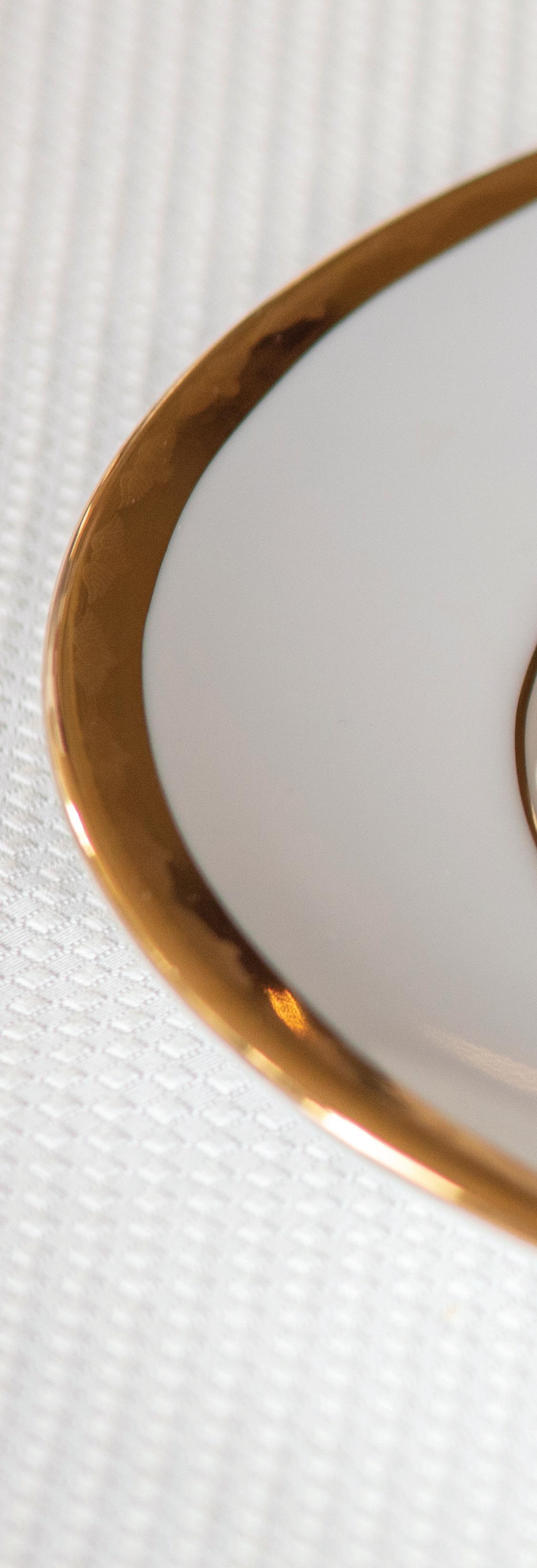
Golf Kitchen Magazine 66
RECIPES BY ED STONE


Golf Kitchen Magazine 68
The “Sahara” bunker on the Lower Course at Baltusrol Golf Club
Image by Evan Schiller
Sriracha Aioli
In a medium bowl, beat the eggs well with a wire whisk. Stir in the minced garlic and gradually add oil in a stream, beating constantly until light and creamy. Season with the sriracha powder, salt, and pepper. Finish with lime juice.
Assembly
Slice the tuna across the grain and fan the slices out onto the center of a plate. Drizzle the yuzu dressing and the sriracha aioli. Garnish the plate with micro greens and add fried wonton strips.
Wine Match
Sauvignon Blanc, Yount Ridge, Oakville, Napa Valley 2017
~ Pairing by Trey Beyliss, Assistant Manager

Nantucket Bay Scallops with Manila Clams, Toasted Fregula, Shiitake Mushrooms, and Lemon Sauce
Serves 4
Ingredients
Nantucket Bay Scallops
• 12 ounces fresh Nantucket Bay Scallops
• Salt and Pepper (to taste)
• 1 Tablespoon Blended Oil
• 1 teaspoon Butter
Fregula
• 1 cup Fregula (toasted)
Shiitake Mushrooms
• 1/2 cup Shiitake Mushrooms (Julienne style)
• 1 teaspoon Oil
Confit Tomato

• 1 Beefsteak Tomato
• 3 sprigs fresh Thyme
• 1 teaspoon Olive Oil
• Salt and Pepper (to taste)
Manila Clams
• 12 Manila Clams
• 1 Tablespoon Shallots (minced)
• 2 ounces White Wine
Lemon Sauce
• 3 Lemons (juiced)
• 2 Tablespoons Butter
• 1 large Shallot (minced)
• 1/4 cup White Wine
• 3 sprigs fresh Thyme
• 1 Tablespoon Parsley (chopped)
• 1/2 cup Heavy Cream
• Salt and Pepper (to taste)

Preparation
Lemon Sauce
Heat 2 tablespoons butter in a saucepan over medium heat and sauté shallots for 2 minutes, until tender. Mix in lemon juice and ¼ 1/4 cup wine. Simmer until reduced by at least half. Stir in cream. Season with parsley, thyme, salt, and pepper. Cook and stir until thickened. Whisk in 1/4 cup butter. Set aside and keep warm.
Confit Tomato
Peel and deseed tomato and cut into quarters. Lay tomato slices flat on a non-stick half sheet pan. Drizzle with olive oil, fresh thyme, salt, and pepper. Cook in 250°F oven for 2 hours. Set aside.
Fregula
Cook fregula in boiling salted water for 8-10 minutes, drain, and set aside.
Shiitake Mushrooms
Preheat a non-stick sauté pan to medium heat, add 1 teaspoon of oil and shiitake mushrooms, cook until lightly browned. Remove from pan and set aside.
Scallops
Season scallops with salt and pepper. Preheat a non-stick sauté pan to medium - high heat adding 1 Tablespoon of blended oil to the pan, (almost smoking point). Add the Nantucket Bay scallops to the pan and sear for one minute on each side. Reduce heat to medium heat and add 1 teaspoon butter, cook for 30 more seconds, remove scallops from pan.
Manila Clams
In the non-stick sauté pan, add clams and 1 Tablespoon of minced shallots. Deglaze with 2 ounces of white wine and cook until clams open, 1-2 minutes.
Assembly
Add scallops, cooked shiitake mushrooms and fregula back into pan. Remove pan from the heat, add 2 ounces of lemon sauce and blend all ingredients together (careful not to let scallops boil). Spoon scallops, mushrooms, and fregula into a serving bowl. Remove clams and place around. Finish with 2 ounces of lemon sauce and garnish with tomato confit.
Wine Match
White Rhone Blend, Paul Jaboulet Aîné Hermitage Blanc le Chevalier de Sterimberg, France 2014
~ Pairing by Trey Beyliss, Assistant Manager

Golf Kitchen Magazine 72
 The Terrace at Baltusrol Golf Club in the evening
The Terrace at Baltusrol Golf Club in the evening

Breast of Duck with Sweet Potato Purée
Caramelized Asian Pear, Maitake Mushrooms, and Red Currant Jus
Serves 4
Ingredients
Breast of Duck
• 4 (6 ounce) skin-on Duck Breast
• Salt and Pepper (to taste)
Sweet Potato Purée
• 3 whole Sweet Potatoes
• 1/2 cup Heavy Cream
• 6 Tablespoons butter
• Salt and Pepper (to taste)
Caramelized Asian Pear
• 2 Asian Pears (peeled, cored and cut into wedges)
• 1 Tablespoons Butter
• 1/2 cup Sugar in the Raw
• 1/4 cup Water
Maitake Mushrooms
• 2 cups Maitake Mushrooms
• 2 cups Brussels Sprouts (leaves only)
• 1 Tablespoon Olive Oil
• Salt and Pepper (to taste)
Red Currant Jus
• 4 ounces Chicken Stock
• 2 ounces Cassis
• 1 Tablespoon Butter
• 2 Tablespoons Red Currants
Preparation
Breast of Duck
Preheat oven to 400°F. Place duck breast skin side-up on a cutting board. Cut crosswise small slits from top to bottom, 1/8 of the way through the duck skin. Season with salt and pepper. Heat a skillet over medium-high heat. Place duck breast skin side-down in the hot skillet; cook until
Baltusrol Golf Club 75
browned, about 30 seconds. Flip and repeat on the other side. Pour off most of the fat, lower heat to medium and flip duck back to skin side down and place in the oven and roast for about 10 minutes. Internal center temperature should be 120°F. Cover with aluminum foil. Let rest for 5 minutes before slicing. Reserve pan for jus.
Sweet Potato Purée
Pre-heat to 425°F. Place potatoes on a foil-lined pan; bake 45 to 60 minutes, until tender. Peel when cool enough to handle. Purée in a food processor, with the motor running, gradually add the heavy cream, salt and pepper, then the butter. Process until silken. Chef Note: You can make up to 2 days ahead of time; store in an airtight container. Reheat and serve.
Caramelized Asian Pear
Melt the butter in a non-stick skillet over medium heat. Sauté the pears and nuts in butter for 3 minutes. Add the sugar and water and cook, stirring constantly, until golden brown and caramelized. Remove from heat and set aside to cool.
Maitake Mushrooms
Lay maitake mushrooms and Brussels sprouts on a sheet pan, drizzle with olive oil and season with salt and pepper. Roast in 350°F oven for 30 minutes.
Red Currant Jus
Return the pan from the duck to medium-high heat. Deglaze pan with 2 ounces cassis then using a wire whisk remove the fond from the bottom of pan. Add 4 ounces of chicken stock and reduce, add 1 Tablespoon of butter and fresh red currants.
Assembly
Take a generous Tablespoon of sweet potato purée and smear on the plate. Slice the duck breast and place across the sweet potato purée. Spoon the roasted Brussels sprout leaves and maitake mushrooms around the duck. Place the caramelized Asian pears next to the duck. Spoon the currant jus over the duck.
Wine Match
Tempranillo, Protos Gran Reserva, Ribera del Duero, Spain 2012
~ Pairing by Trey Beyliss, Assistant Manager

Golf Kitchen Magazine 76
 The second hole of Baltusrol’s Lower Course. Image by Evan Schiller.
The second hole of Baltusrol’s Lower Course. Image by Evan Schiller.
Poached Oysters with Spinach, Saffron and Balsamic Pearls

Serves 4
Ingredients
Poached Oysters
• 12 Blue Point Oysters
Spinach
• 4 cups Spinach (wilted)
Balsamic Pearls
• 2 cups Blended Oil
• 3/4 cup Balsamic Vinegar
• 2 Tablespoons Agar Flakes
Beurre Blanc
• 1/2 cup Dry White Wine
• 2 Tablespoons Lemon Juice
• 2 Tablespoons Heavy Cream
• 2 teaspoons Shallots (minced)
• 4 ounces Cold Butter (cut into 1-inch cubes)
• Salt and Pepper (to taste)
• 1 pinch Saffron
Preparation
Balsamic Pearls
Place the oil in a small bowl and set in the refrigerator for 30 minutes. Place the balsamic in a small pot and sprinkle the flakes in. Let sit 10 minutes. Heat the balsamic and agar to a boil, stirring constantly to dissolve the flakes. Let cool. Using a dropper, form drops of the balsamic into the cool oil. Remove from oil and set aside.
Beurre Blanc
Place wine, lemon juice, cream, shallots, and cream in a saucepan. Bring to a simmer over medium-high heat. Reduce heat to medium and let simmer until liquid is reduced by about 75%, 4 to 5 minutes. Reduce heat to the lowest setting and whisk in about 2 cubes of butter. Keep butter moving until it melts. When melted, add a few more cubes, whisking continuously so butter emulsifies
Golf Kitchen Magazine 78
Image by Helen Healey

Baltusrol Golf Club 79
into the wine/lemon juice mixture. Continue to add butter, a few cubes at a time until all of it has been incorporated, 4 to 6 minutes. Remove from heat. Add pinch of saffron, salt and pepper to taste. Keep warm.
Oysters
Shuck the oysters and place in a non-reactive pot with 1 teaspoon of minced shallot and 2 ounces of white wine. Place on low heat (being careful not to boil). Clean the oyster shells and place on a bed of sea salt. Place a nonstick sauté pan on medium heat, add 1 Tablespoon of blended oil and spinach, and cook until slightly wilted.
Assembly
Place 1/2 of the wilted spinach on the bottom of the shell. Remove the oysters and place on top of spinach. Place remaining spinach on top of the oysters. Spoon saffron beurre blanc on top. Garnish with balsamic pearls. Serve immediately.
Wine Match
Rene Geoffroy Extra Brut Millesime Champagne, France 2008
~
Pairing by Trey Beyliss, Assistant Manager

Golf Kitchen Magazine 80
 The Eldridge Room at Baltusrol Golf Club
The Eldridge Room at Baltusrol Golf Club
Braised Short Rib with Gruyère, Polenta, Roasted King Oyster Mushroom, Vegetables and Sofrito
Serves 4
Ingredients
Braised Short Ribs
• 5 pounds Bone-in Beef Short Ribs (cut crosswise into 2-inch pieces)
• 3 Tablespoons Unsweetened Coco Powder
• Kosher Salt and freshly ground Black Pepper
• 3 Tablespoons Blended Oil
• 3 medium Onions (chopped)
• 3 medium Carrots (peeled and chopped)
• 2 stalks Celery (chopped)
• 1 Tablespoon Tomato Paste
• 2 cups Dry Red Wine (preferably Cabernet Sauvignon)
• 10 sprigs Flat-leaf Parsley
• 8 sprigs Thyme
• 4 sprigs Oregano
• 2 sprigs Rosemary
• 2 Bay Leaves (fresh or dried)
• 1 head of Garlic (halved crosswise)
• 4 cups Beef Stock
Gruyère Polenta
• 1 cup Polenta
• 4 cups Chicken Stock
• 3 Tablespoons Butter
• 1/2 cup Gruyère Cheese
• Salt and Pepper (to taste)
Roasted King Oyster Mushroom

• 12 large King Oyster Mushrooms
• 1 Tablespoon Olive Oil
• Fresh Thyme
Golf Kitchen Magazine 82
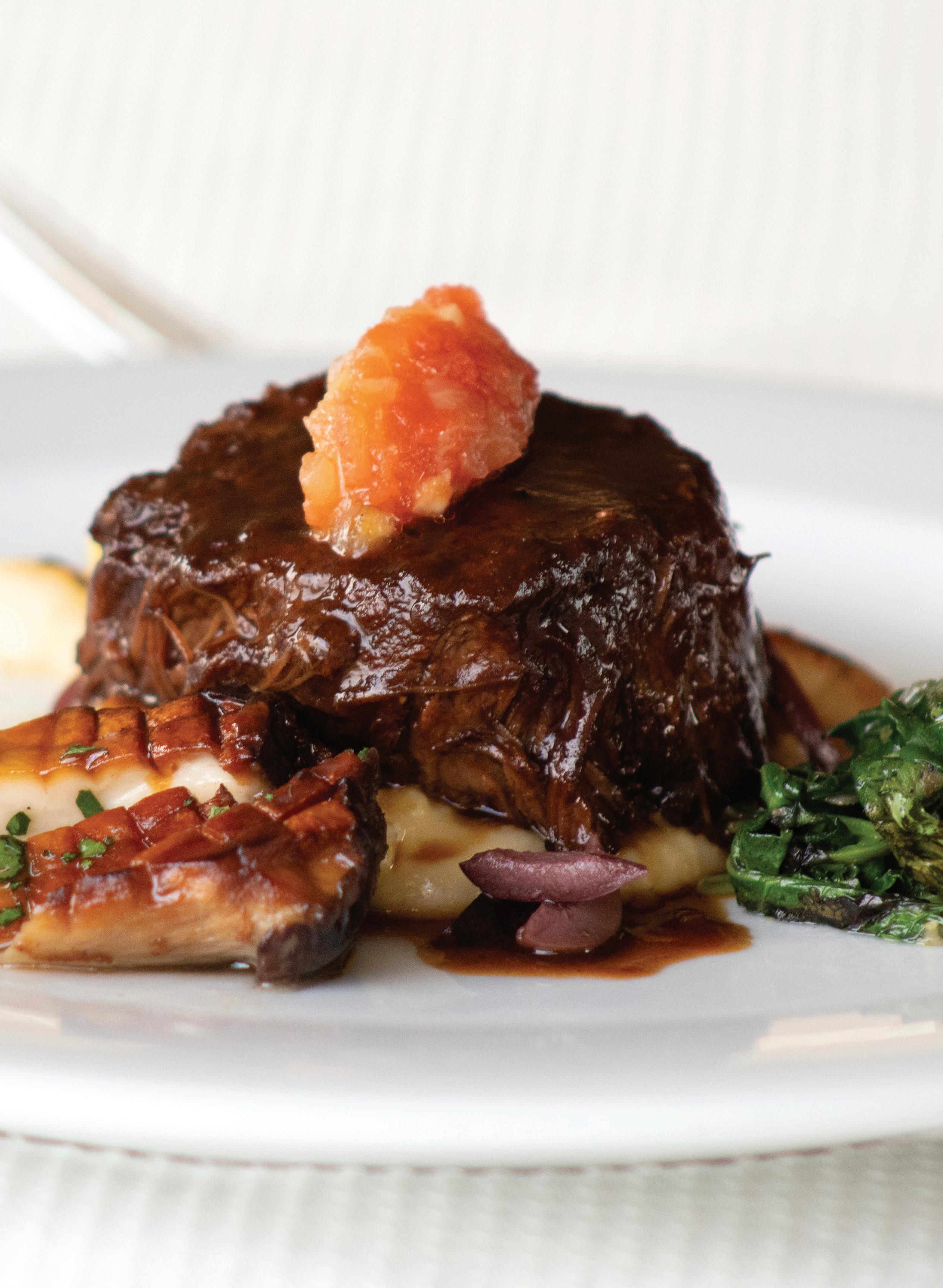
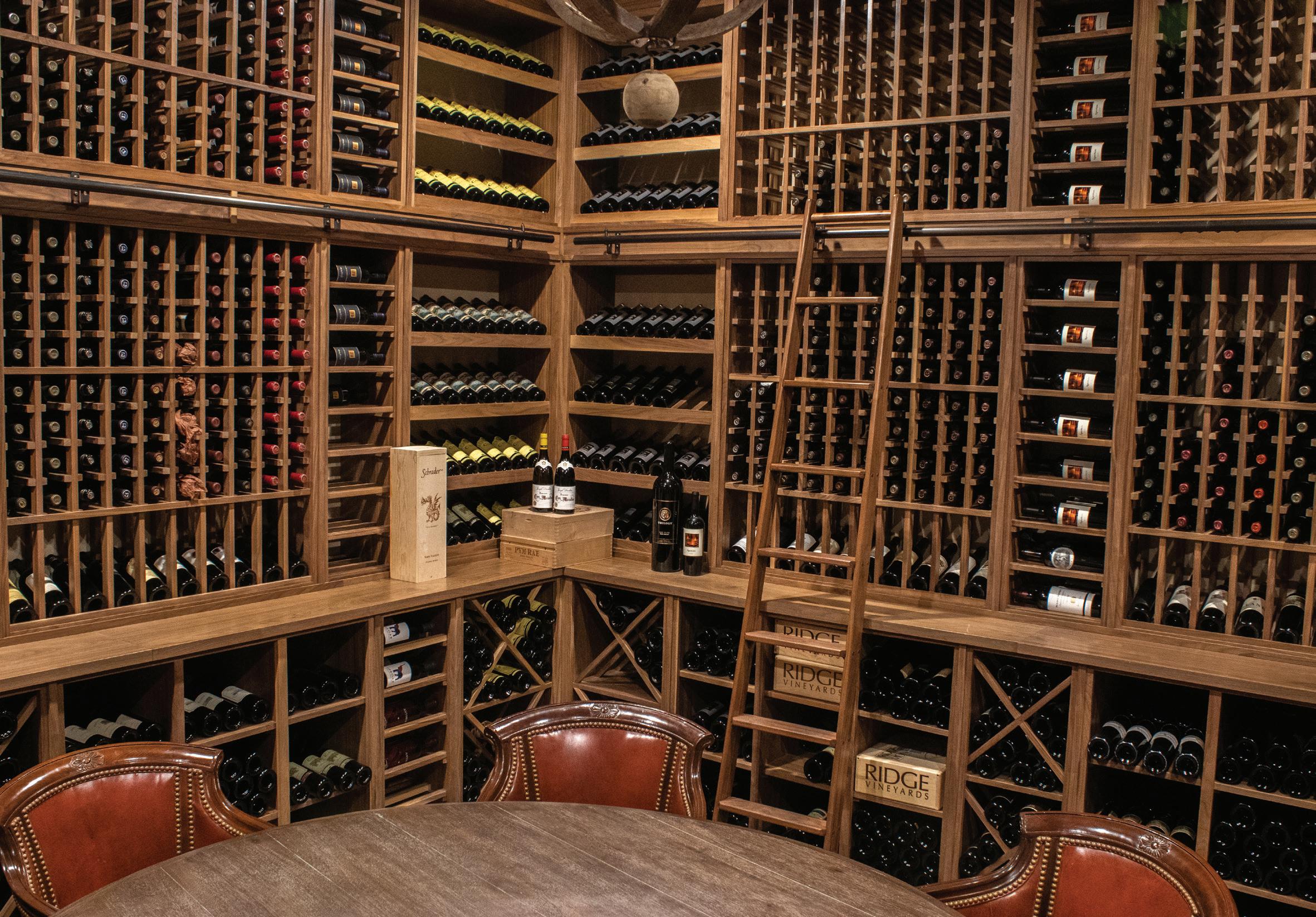
 The Trophy Room displays Baltusrol’s renowned championship history.
The Wine Cellar at Baltusrol Golf Club
The Trophy Room displays Baltusrol’s renowned championship history.
The Wine Cellar at Baltusrol Golf Club
Sofrito
• 2 Red Onions (diced)
• 3 cloves Garlic (minced)
• 1 Red Bell Pepper (diced)
• 1 Yellow Pepper (diced)
• 1 bunch Cilantro (chopped)
• 2 Tablespoons Oregano
• 1 Tablespoon White Wine Vinegar
• 1 teaspoon Ground Cumin
• Salt and Pepper (to taste)
Organic Baby Kale
• 1 Tablespoon Olive Oil
• 1 Shallot (minced)
• Salt and Pepper (to taste)
Preparation
Braised Short Ribs
Preheat the oven to 350 °F. Season the short ribs with salt, pepper and coco powder. Heat the oil in a large heavy-gage roasting pan over medium-high heat. Working in 2 batches, brown the short ribs on all sides, about 8 minutes per batch. Transfer the short ribs to a plate. Pour off all but 3 Tablespoons of drippings from the pot. Add the onions, carrots, and celery to pot and cook over medium-high heat, stirring often, until onions are browned, about 5 minutes. Add the tomato paste and cook, stirring constantly, until well combined and deep red, 2-3 minutes. Stir in the wine. Add short ribs with any accumulated juices. Bring to a boil, then lower heat to medium and simmer until the wine is reduced by half. Add all the herbs to the pot along with garlic. Stir in the stock. Bring to a boil, cover, and transfer to the oven. Cook until short ribs are tender, for 2–2 1/2 hours. Transfer the short ribs to a platter. Strain sauce from the pot into a measuring cup. Skim the fat from surface of the sauce and discard. Reduce the liquid to sauce consistency and add salt and pepper to taste.
Gruyère Polenta
In a large saucepan, add the chicken stock and salt then bring to a boil. Pour the polenta slowly into the boiling chicken stock, whisking constantly until all polenta is stirred in and there are no lumps. Reduce heat to low and simmer, whisking often, until the polenta starts to thicken, about 5 minutes. Polenta mixture should still be slightly loose. Cover and cook for 30 minutes, whisking every 5 to 6 minutes. When polenta is too thick to whisk, stir with a wooden spoon. Polenta is done when texture is creamy. Turn off the heat and gently stir 2 Tablespoons butter into the polenta until the butter partially melts.
Mix 1/2 cup of the Gruyère cheese into the polenta until the cheese has melted. Cover and let stand for 5 minutes to thicken. Adjust seasoning with salt and pepper to taste. Set aside and keep warm.
Roasted King Oyster Mushroom
Place the mushrooms on 1/2 sheet pan. Drizzle with olive oil and season with the thyme, salt, and pepper. Place in 350°F oven for 30-40 minutes. Set aside.
Sofrito
Mix all of the ingredients in a non-reactive bowl and refrigerate for at least 24 hours.
Gnocchi Vegetables
Use a scalloped edge Parisian scoop and blanch vegetables in boiling salted water until done, toss in the butter, salt, and pepper. Chef Note: Use your own choice of vegetables, including zucchini, parsnip, carrots, celery root, and yellow squash.
Organic Baby Kale
In a medium non-stick sauté pan heat the oil. Add the kale and minced shallots. Cook until lightly wilted. Remove from the pan and set aside.
Assembly
Take a Tablespoon of the polenta and place it in the middle of the plate. Place the short rib on top of the polenta. Add the gnocchi vegetables, kale, and king oyster mushroom to the plate. Spoon the sauce on top of the short rib. Using a teaspoon size, make quenelle out of the sofrito, best if room temperature, and add on top of short rib. Serve immediately.
Wine Match
Bordeaux Blend, Baron Philippe de Rothschild ‘Almaviva’, Maipo Valley, Chile 2017
~ Pairing by Trey Beyliss, Assistant Manager
Baltusrol Golf Club 85
 Juan Pablo de la Sota Riva Leal, Executive Chef at Royal Poinciana Golf Club
Image by Stephanie Starr
Juan Pablo de la Sota Riva Leal, Executive Chef at Royal Poinciana Golf Club
Image by Stephanie Starr
Buy Local and Keep your Menu as Fresh as the Food
By Juan Pablo de la Sota Riva Leal, Executive Chef
At Royal Poinciana Golf Club, we were committed to buying locally farmed produce for our Membership. Two years ago, we started a partnership with Jonathan and Isabel Way of Calusa Farms in Naples, Florida. Not only are they dedicated to growing environmentally friendly, sustainable produce, but they maintain Royal Poincinan’s Golf Club’s hydroponic garden.

Isabel comes from a multi-generational family of farmers who still produce quality products in Colombia. She moved to the United States after earning her degree in environmental sciences. Her expertise in plant science led to Collier County’s Master Gardner and Florida Friendly Landscaping Coordinator position from 2013 until 2018.
Jonathan’s love for building hydroponic gardens started when he was young and became his business after moving to Florida. He worked with local chefs to develop the quality of produce that their high standards required. Calusa Farms does an excellent job of meeting that need.
From Farm to Fork
In addition to Calusa Farms, we have also connected with other great local businesses to ensure we always get the quality ingredients we need to provide our members with healthy, delicious food. One of those business includes Southern Florida’s Farmer Mike’s.

Just a few miles north of Naples in Bonita Springs, Farmer Mike’s started more than 30 years ago as a small roadside produce stand and blossomed into one of the state’s premier growers. They have more than 200 acres. They grow squash, zucchini, beans, corn, strawberries, onions, eggplants, every kind of tomato and pepper you can think of, and even numerous types of ornamental and edible flowers. Many of these items you can pick yourself on the farm or stop in quickly at the farm stand — both of which can be done every day from 9 am to 5 pm.
Recently, our culinary team had the opportunity to visit Farmer Mike’s for a tour given by Farmer Mike himself and his Sales Manager Dustin. They educated us on their growing processes of many different fruits and vegetables, in addition to some of the newer things they have been working on. They are always innovating and learning how to create the best organic products. They don’t use pesticides or any other harsh chemicals. They made a water irrigation system to save water during the rainy season to use during the dry season. They have beehives for pollinating their plants and have developed better vertical growing methods to maximize the use on their farm’s land.
We have built a strong relationship with Farmer Mike’s. We can place an order for products in less than 24 hours, and it comes from the farm’s fields to our hands. Supporting local businesses help to keep our communities prospering during challenging times.
Royal Poinciana Golf Club’s Executive Chef Juan Pablo de la Sota Riva Leal was born in Mexico City and studied at the Ambrosia Culinary Center. He later moved to Madrid, Spain, for an internship in a two-Michelin-Star Restaurant called La Broche. Juan Pablo has worked at many prestigious restaurants before joining “Team RP.”










YOUR PASSION IS OUR SCENE! CONTEMPORARY CULTURE Issue_38 42 CULTURE CONTEMPORARY CULTURE Issue_43 VenuMagazine.com CONTEMPORARY CULTURE Issue_28 For a complimentary digital Venü subscription, sign up for the Ü-List on our website:
THE CHEF’S GARDEN:
A Modern Guide to Common and Unusual Vegetables—with Recipes
This is the title of the new book by The Chef’s Garden and, in it, Farmer Lee Jones shares the knowledge they’ve gained over the years on how to select, prepare, and cook vegetables. It’s a guidebook with more than 500 entries, ideal for home cooks who love to include fresh vegetables in their family’s meals—and it also contains 100 recipes created by the head chef at the Culinary Vegetable Institute of The Chef’s Garden. Entries range the gamut of commonly known veggies to unusual ones, and from herbs to edible flowers. Recipes include the following: Beet Marshmallows, Cornbread-Stuffed Zucchini Blossoms, Onion Caramel, Ramp Top Pasta, and Seared Rack of Brussels Sprouts.
The tone of this comprehensive guidebook is approachable and friendly, just like Farmer Lee Jones himself, and it shares innovative techniques to transform vegetables in your kitchen. The book captures the essence of the farm, one that grows and harvests with the belief that every part of a plant offers something unique on the plate.

Vegetables are at the forefront of cuisine in this increasingly plant-forward world, and this book will transform the way you think about, eat, and cook them.
This book (one you’ll reach for, again and again!) will be available on April 20, 2021. Although A Modern Guide to Common and Unusual Vegetables—with Recipes is big news, that’s not all that’s happening on the farm. Farmer Lee and his team are busy with their home deliveries of fresh vegetables and they’re excited about nutritional information about those vegetables being confirmed by an independent lab.
Golf Kitchen Magazine 90
The Soil is the Heart of The Chef’s Garden.
Farmer Lee and his family have long believed that, if they nurture their soil and treat it like its own crop, the added flavor this provides would also result in fresh vegetables that burst with nutrition. This was confirmed in their own agricultural research lab—and now has been independently verified: vegetables from The Chef’s Garden actually have 300 to 600 percent more in nutrients than the USDA baseline.
Vegetables grown at The Chef’s Garden are especially nutrient rich because they use regenerative farming techniques that allow them to naturally enrich the soil. At a high level, this means they strategically use diverse cover crops to build up the soil; till, only as needed, and gently at that; and allow two thirds of their fields to lay fallow each year so that the soil can rest and be appropriated, fed and watered.
This is in direct contrast to today’s conventional farming techniques where crops are grown for maximum yield—rather than for optimal flavor and nutrition—and where chemicals are used. At The Chef’s Garden, the team farms in harmony with Mother Nature for healthy soil, healthy crops, healthy people, and a healthy planet.
This is in direct contrast to today’s conventional farming techniques where crops are grown for maximum yield—rather than for optimal flavor and nutrition—and where chemicals are used. At The Chef’s Garden, the team farms in harmony with Mother Nature for healthy soil, healthy crops, healthy people, and a healthy planet.

So: new book, home deliveries, and powerful nutritional verifications! With all of this good news, you can understand why Farmer Lee is smiling on the new book’s cover.
Story by Kelly Boyer Sagert
The Chef’s Garden 91

Beet Marshmallows

Please enjoy a preview of one of the many creative recipes in the new book by Farmer Lee Jones.
Yields 8-9 dozen
• 1 cup (240 ml) fresh red beet juice, chilled (from 5 or 6 beets)
• 3 (1/4-ounce) envelopes unflavored powdered gelatin
• 1 3/4 cups (350 g) granulated sugar
• 1 cup (240 ml) light corn syrup
• 1/2 teaspoon kosher salt
• 1/2 vanilla bean, seeds scraped
• Vegetable oil spray
• 2 tablespoons (15 g) confectioners’ sugar
• 2 tablespoons (15 g) cornstarch
Beet marshmallows bring a grown-up twist to classic s’mores when roasted over a fire. They’re also perfect for old-fashioned root-vegetable casseroles. Play around with using juice from other vegetables. Instead of corn syrup, you could use honey or maple syrup. Figure on this taking about 5 hours before the marshmallows are ready to eat.
In the bowl of a stand mixer, combine half the beet juice with the gelatin. Have the whisk attachment standing by. Let sit until gelatin is softened.
In a small saucepan, combine the remaining beet juice with the granulated sugar, cor11 syrup, a11d salt and cook over medium-high heat, stirring occasionally, until the mixture reaches 240°F, 10 to 12 minutes. Immediately remove from the heat.
Fit the mixer with the whisk attachment. With the bowl in place and the machine on medium speed, gradually and carefully pour the hot beet syrup down the side of the bowl into the gelatin mixture.
Increase the speed to high and whip until the mixture becomes very thick, bright pink, and is lukewarm, 12 to 15 minutes. Add the vanilla seeds during the last mi11ute of whipping.
Lightly spray two 9 by 13-inch baki11g pans with the vegetable oil.fe
In a bowl, sift together the confectioners’ sugar and cor11starch. Dust the baking pans with some of the mixture and shake the pans to evenly coat the surf ace; tap out any excess onto a plate and reserve.
Using a lightly oiled spatula, transfer the beet mixture to the pans and spread evenly. Dust the top with just barely enough of the remaining cornstarch mixture to lightly cover; reserve the extra for later use. Let stand uncovered for at least 4 hours and up to 12 hours.
Turn the marshmallows out of the baking pans onto a cutting board and cut into I-inch squares. Lightly dust all sides of the marshmallows with the remaining cornstarch mixture.
The Chef’s Garden 93
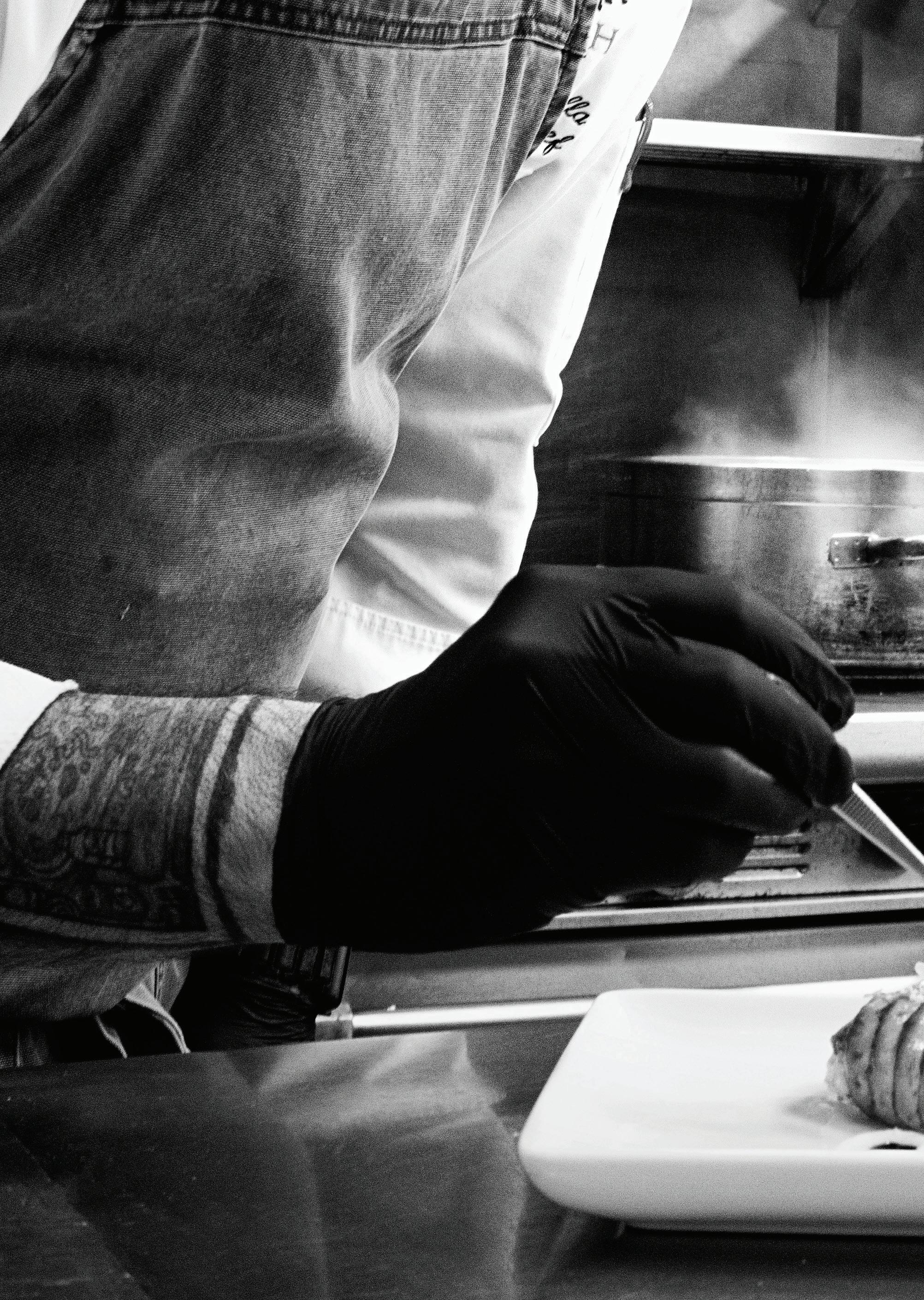


Image by Ambria Michelle. Cover DominicStoryCalla Executive Chef Round Hill Club Greenwich Connecticut
Dominic Calla Executive Chef Round Hill Club
For ten years, I have wanted to produce an article featuring the Round Hill Club in Greenwich, Connecticut. I had heard from many influential industry people about the grace and talent of their Executive Chef Dominic Calla. It is an honor to bring his story to you. ~ Diana
DeLucia
GK: Tell us about your background and how you developed an interest in cooking and cuisine.
My father Gaetano Calla was born in Calabria, Italy, and his family moved to the United States when he was just eight years of age. I grew up on Long Island. The majority of my family is still in Italy. I am the fifth or sixth generation born in this country, and I have an older brother and a couple of older cousins. They lived in Brooklyn. My early childhood was a typical Italian household; we had the Sunday dinners that lasted from two o’clock until seven o’clock, took naps, and watched soccer. That was my introduction to food. I don’t think it held any meaning for me at that time.
GK: Where was your first job?
A little restaurant in Ocean Beach, New York, called the Sand Bar and Grill. It’s not in operation anymore, but that was my first introduction to the kitchen. I was 15, and I washed dishes, scrubbed mussels, cleaned calamari, peeled potatoes, and basically performed the kitchen’s grunge work. I enjoyed it, and it was where the initial attraction began. Being there got me out of my head. It was
a place where I didn’t have to think about anything else that was going on. I could focus on work. I enjoyed the people that I worked with, the pace of it, and the chaos. The thrill of getting through to the end of the night as a team was memorable.
I started traveling when I turned 16. I worked as a line cook in California for a year and a half, then I did six months in Maryland, and a year or so in Athens, Georgia. When I was 20, I moved back to New York and started a job as a line cook at The Inn Between in Ocean Bay Park for the summer. The Executive Chef Scott Everett offered me the Sous Chef position, and I accepted.
Towards the end of the summer season, I was looking for something to fill in the time until the next season. My brother and his then-fiance moved to West Virginia, so I decided to go with them after the season closed.
When I arrived in West Virginia, I found a small restaurant, Mario’s Fish Bowl. It was a little dive bar and restaurant in Morgantown. They were opening up a fine dining restaurant next door, and I ended up landing a job to open up this restaurant for them. I had no idea what I was doing! None. I had never built or designed a kitchen. I walked into an old automotive shop, and there was a car lift in the kitchen, and they said, “Dominic, this is your kitchen.” Oh my goodness, I thought to myself. There was no internet back then, and I had to search through catalogs to research kitchen equipment and the rest of what was needed. I spent six to eight
Golf Kitchen Magazine 96
INTERVIEW

months designing that kitchen, and I succeeded. I wrote the menus and had them ready to open.
After that I returned to New York, which was always my home base. Shortly before the September 11th attacks, I decided to take a South Florida position in Naples as a line cook at Gabrielo’s of New York. It was a fine dining restaurant. They had a grand piano and celebrity clientele such as Carol Burnett and Tony Curtis. The Executive Chef got fired, and that was my first introduction to the Executive Chef role. I was just 23.
Once again, I had no idea what I was doing. However, I was still learning when I took over as Executive Chef at Gabrielo’s. That is when the light switch turned on for me. Previously it was a means to travel; I could go wherever I wanted and would pick up a position at that location. Now I could see that this was a career. I wasn’t a great manager or leader, but I knew how to operate a kitchen, write menus, and order. I made a ton of horrible dishes, and I’m not even kidding. (laughs) The internet was in its infancy, so magazines like Food and Wine and Art Culinaire are where I found inspiration. I would dine at other restaurants, and if I loved a dish, I would try to recreate it. Trial and error and pushing myself were a big part of my career path. So much of my early career was me biting off way more than I could chew! I stayed at Gabrielo’s for two years, and it was excellent training and boosted my confidence.
At that point, I found a restaurant group that owned three restaurants in Athens, Georgia, a French bistro called Basil Press, a high-end steak house called Porterhouse Grill, and a brewpub, Copper Creek Brewing Company. All three restaurants were in downtown Athens, Georgia. They were looking for an Executive Chef of all three, and I went for it, and I got it.
I had a sous chef at each restaurant. I still worked the line every night, but I was introduced to three restaurants’ inventory and mass ordering. I learned how to set up prime vendor agreements and ordering under the company name and not each restaurant. Andy Urell, one of the owners, was a chef. Michael White, another owner, was a server and bartender who was studying to be a master sommelier. It was great because I got a lot of training from Andy, who taught me a lot about French cuisine. Michael taught me a lot about wine. My time there was instrumental to my career, and I stayed for two years. After that, I
decided to move back to Naples, Florida, and look for the next step in my career.
GK: How did you land in the private golf and country club industy?
I applied for a supervisor position at The Hyatt Regency Coconut Point in Bonita Springs, Florida, which is getting closer to a Country Club environment. They offered me a sous chef position, and then a year and a half later promoted me to the chef de cuisine of their fine dining seafood restaurant. I had a lot of fun at this restaurant. I had no food costs. I could order whatever I wanted. I ordered $70,000 worth of Chef’s Garden product in one year. I got to play around with whatever food I wanted. It was a seafood restaurant, and at one point, I had 18 different catches on my menu. It was fish from Honolulu Seafood Company and Europe. I brought in Chinese Black Chickens because I had heard how good the soup is with them. I
even ordered duck tongues, and I did Buffalo Duck Tongues as an appetizer at the bar. I continued to be enthralled for another year and a half.
The executive sous chef position for the entire hotel opened up, and I applied for it internally. I got promoted to the hotel’s executive sous chef at the Hyatt Regency Coconut Point in Bonita Springs. This was another huge learning curve because now I got pulled out of the kitchen and my little comfort zone playing with food every day. The Executive Chef there at the time was John Benson. He’s now a General Manager at a Hyatt in Hawaii. John Benson started to teach me the other side of operations, such as scheduling, forecast budgets and carrying myself as a professional. I stayed in that position until 2010.
I was burnt out by this time as they had me taking interim chef positions at other properties
”Trial and error and pushing myself were a big part of my career path.”
Golf Kitchen Magazine 98
in South Beach that needed over-the-top menus but relied on temporary kitchen staff. I left Hyatt about two months later. I needed a break.
GK: What did you do during your break?
A group of executive chefs and executive sous chefs in Naples worked as private chefs for folks who rented the big mansions for a week. I did this for a year, and I then wanted to explore working in a private golf or country club. I had enough confidence and a great career portfolio that would overpower the lack of a culinary degree.
Meyers and Associates over the phone. Two and a half years into my position at Hillsboro, I gave him a call to see if he could help me gain a position in Richmond, Virginia. My brother had moved there, and we hadn’t seen each other in years. He called to tell me how great the food scene was. David had found a position at Hermitage Country Club. I flew to Richmond, did all the tasting tests, but the food and beverage director didn’t like my background and flatly said no.
I went back to Florida, and David called and told me that he might have something at The Country Club of Virginia (CCV). David was having a conversation with Phil Kiester, the General Manager at CCV, and Phil told David that he needed a chef to run the James River clubhouse. David’s said, “I’ve got a guy in Florida who is trying to move up here. He has a colorful background.” Phil asked, “can he do the job?” And David replied, “yes.” From there, I was fasttracked to CCV.
GK: Tell us about your first private club experience.
I was hired as the executive sous chef at The Hillsboro Club in Hillsboro Beach, Florida. It’s a small racket club, but it’s been there forever. The members live there for about seven months of the year. So you see these people for breakfast, lunch, and dinner every single day. If something is wrong at breakfast, they will let you know at lunch, and then at dinner, they would tell their friends. The next morning they’d come in for breakfast to see if you fixed it. It drove me crazy! It wasn’t like a hotel where they check-in Friday and check-out Sunday and see you later. No, no, it was more like Ms. Montgomery was upset with breakfast, and I’m going to see her the next morning!
It was a wake-up call to me, plus I needed to learn everyone’s names by heart and talk to every member during service. But for some reason, it felt a little better. It wasn’t always about the bottom line. Your food cost was 23.4% in the hotel, and then they want you to come down to 22%. At Hillsboro, I could blow the budget on an event for the members because we wanted to create a memorable experience. We could make up for the budget later in the season.
I stayed at Hillsboro for three years, and during that time, I had met David Meyers from David
After interviewing and some cooking demos, I took over as Executive Chef of the James River clubhouse. The first day I showed up at work, the Executive Chef of the entire property Gary Whitecotton welcomed me and then said, “This is my last day. I have resigned.” I remember calling David Meyers and said, “what did you do to me? You just started me at a club, and the Executive Chef is leaving on my first day, and then three weeks in, the Executive Sous Chef had a month off.”
I settled in quickly and adjusted. After a few months, we started interviewing for the next Executive Chef position of the entire compound. Keith Armstrong was one of the candidates, and fortunately, they hired him. I immediately connected with Keith. He was no stranger to clubs and knew the routines well. Keith was an outstanding mentor for me for the next threeplus years.
We did many creative events and had a garden that we eventually turned into an event space. We started doing parties at an old farmhouse on the property. We were coming up with many ideas together; we fed off each other. CCV had signed up to do the Dominion Energy Charity Classic; we worked really hard to plan and execute menus and all the other facets of this PGA event. The first year was the most challenging as we planned 200% of what we didn’t need and six percent of what we did need!
Round Hill Club 99
“Positions like this one at RHC only become available every 10-15 years.”
The following season, Keith turned up in my driveway with this huge wooden backdrop with things hanging on it. He said, “we’re going to have stations, and we’re going to have backdrops. They will have lanterns hanging from it and flowers.” His creativity was endless.
After that second PGA Tour event, I learned that Keith took the Westchester Country Club position. After another year at CCV, I started looking around for an executive chef position where I was the chef in charge of the property. I gained a job at the Dominion Club. It was owned by the Heritage Golf Group who had about nine properties. I had the impression it was a financially stable operation. They hired me to turn around the food and beverage operations, and I would have everything that I needed to make it happen. However, when I arrived at the club, it was nothing that was painted. I called Phil Keister at CCV and told him that I did not want to work in a corporate golf club. They were in talks to buy and take over the Heritage Golf Group properties. I handed them my resignation and thought, “that was a crazy nightmare.”
Phil asked me to return to CCV as it was a few months before the next PGA Tour event. I stayed for seven months and worked with John York, who took over from Keith. It was great for a time, but Phil and I knew this would not be a longterm arrangement.
GK: How did you land at Round Hill Club?
I got a phone call from Keith, and he told me about an opening at Round Hill Club (RHC) in Greenwich, Connecticut. He said, “RHC is right up your alley.” I got off the phone with Keith and called David Myers, and I said, “David let’s go with this.”
I interviewed with Brian Walshe, the general manager, and his assistant GM Mary Schaffer. They flew me up here for a night, and a day later, they asked me to return for a second interview. I returned and enjoyed dinner with Brian and Mary. We got along very well, and it was very much a personality fit. Positions like this one at RHC only become available every 10-15 years.
I continued with the interview process and the cooking demo, and about a day later, Brian offered me the position, and it was like, “okay!”
I started in September of 2019. I experienced the end of the golf season and the entire holiday season, and then we shut down in March.
GK: That was a shocking time for all; how did you find the positives?
During this Covid time, I tried to find the positive side of it. I used the time to get to know many of the members better as it was not as busy. I made it my mission to learn more about what they want, what they like, what they don’t like, and how much I can push them to try new things. They had the same chef for eight years and then the same chef for 20 years; I had my work cut out for me for sure.
Brian and Mary were great presenting me to the members. There are way fewer members at RHC than CCV, and it was excellent as I could talk to them freely and ask them questions about what they want and need.
GK: Apart from Keith Armstrong and your work peers, tell us some of the Chefs that inspire you.
Chef Gunter Seeger, the German Chef, who anchored himself at the forefront of Atlanta’s fine dining scene for 25 years. I started to follow chefs like Eric Ripert, Daniel Boulud, JeanGeorges Vongerichten and Gabriel Kruether. They inspired me immensely. I knew at a club, I couldn’t make the food they were doing at their restaurants, but I could experiment with larger versions.
It’s an art form in a club, more so than a restaurant, because you want to be creative and you want to present amazing things, but you still have to be not too big and not too small. It has to be presented well, and you’re able to do something fine, but in a proportion that’s going to make everyone happy.
GK: Have you changed much of the menu in your year and a half here?
There’s always a portion of the menu that you can’t touch. However, slowly I’ve started making small changes to a couple of them. Currently, I have about half the menu that I can change. That’s 12 or 13 dishes. The first Wednesday of every month, we change five dishes on the dinner menu and four on the lunch menu. I
Golf Kitchen Magazine 100
would come up with new specials each week. We became bold with the specials. I was making Peking Duck as a special to see if they order it.
GK: What are your culinary plans at Round Hill Club in the future?
I have quickly come to realize this is a special place. The membership has been so welcoming and a pleasure to get to know. My first six months were what you would expect, the end of the golf season, the beginning of paddle season, and all the holidays. We close for three weeks each March, and the first half of my season was perfect. When lockdowns began mid-March, it was time to make a plan and strategize. We started offering curbside menus and making cooking videos in my kitchen at home for the membership. We increased the number of wine dinners we did and got creative with every event we would have normally had.
Despite this past year, we have continued to make strides forward for the membership. We change the menu monthly and are always running different specials. As the chef, I continue to teach and develop my staff. I ordered a whole swordfish to show the team how to break it down. We recently brought half of a hog to teach the staff how to butcher it and make charcuterie. I continue to try and plan trips for the culinary team to visit farms or other clubs to keep their interests peaked. We are getting ready for our March closure again, and I am excited that we have a hectic season coming up. I am looking forward to getting back to normal and offering all we do for the membership and more.
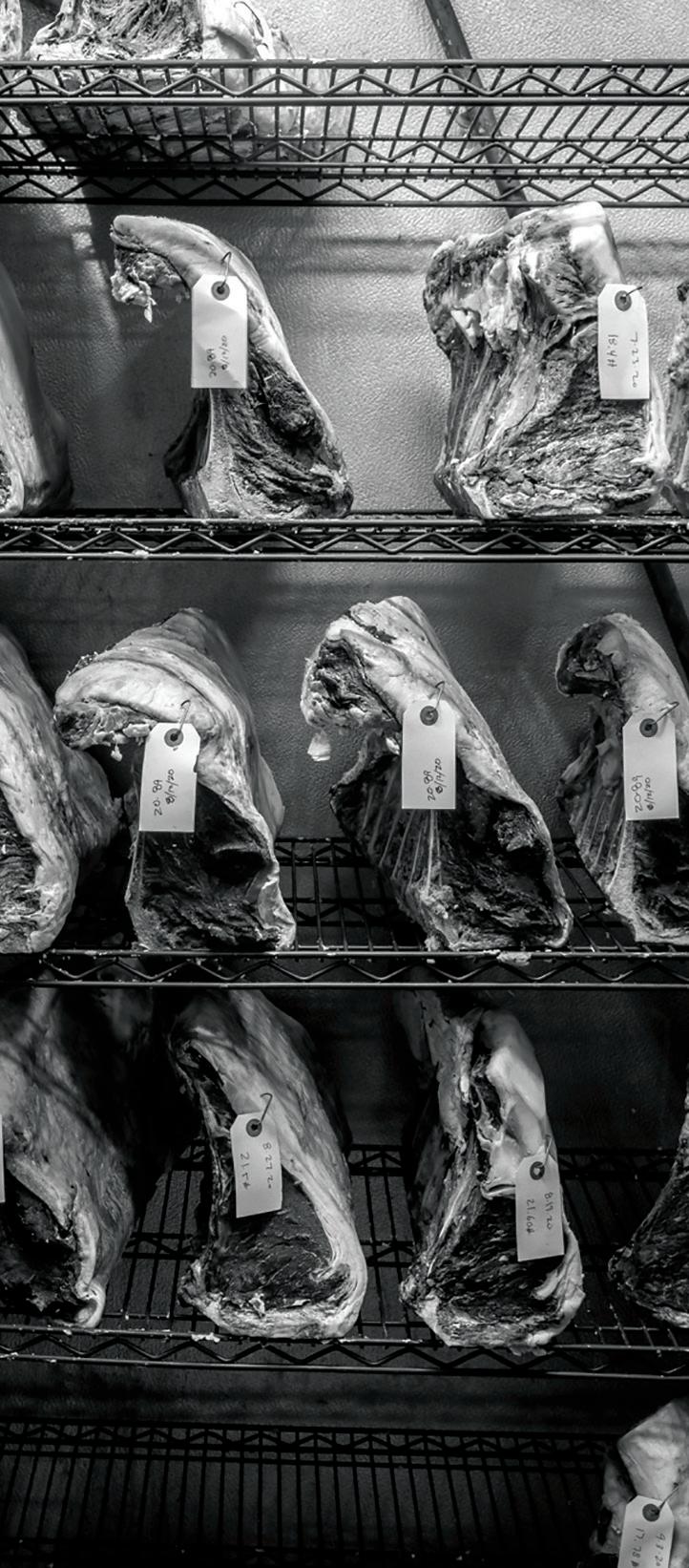
Round Hill Club 101
RECIPES BY DOMINIC CALLA
Kumamoto Oyster with Caviar, Uni, and Quail Egg



Golf Kitchen Magazine 104
Yields 4
Ingredients

• 12 Kumamoto Oysters
• 12 Quail Eggs
• 2 ounces Caviar (of your choice)
• 1 tray Sea Urchin Roe (Uni)
Garnish
• Coarse Kosher Salt
• Pink Peppercorns
• Micro Greens (supplied by The Chef’s Garden)
Preparation and Assembly
Shuck the oysters separating the bottom abductor mussel as well.
Cut the tops off of quail eggs with a knife and separate the yolk and the white.
Gently roll the egg yolk into each oyster shell. Place one piece of Uni in each oyster shell. Place a spoonful of caviar into each oyster shell. Arrange oysters on top of the salt, pink peppercorns, and microgreens.
Serve immediately after assembly.
Chef Note: Any left-over Uni can be turned into Uni butter by puréeing in a food processor and adding softened butter, lemon juice, and sea salt. Roll the butter in parchment paper and freeze to be used in another dish.
Wine Match
Bodegas del Palacio de Fefinanes, “1583”, (oak aged) Albarino, Rias Baixas, Spain 2019.
These ingredients are earthy, briny and rich (yolk.). I would look for a wine with a bit of oak/texture to hold up to the egg but a salinity that will marry with the oyster.
~ Mary Schaffer, Assistant General Manager
Round Hill Club 105
Watermelon and Feta Salad with Pomegranate Molasses, Feta Cheese, Cucumber, Red Onion, Micro Basil, and Borage Flowers
Yields 4
Ingredients
Salad
• 1 Seedless Watermelon
• 1 block Feta Cheese
• 1 English Cucumber
• 1/2 Red Onion (minced)
• Micro Basil to Garnish (supplied by The Chef’s Garden)
• Borage Flowers to Garnish (supplied by The Chef’s Garden)
Pomegranate Molasses
• 4 cups Pomegranate Juice
• 1/4 cup Sugar
• 1 Tablespoon Lemon Juice
Cucumber
• 1 English Cucumber
• 1 cup Champagne Vinegar
• 1 cup Water
• 1 Tablespoon Kosher Salt
• 3 Tablespoons Sugar
Preparation
Pomegranate Molasses
Bring all Ingredients to a boil over medium high heat. Reduce heat to a simmer and reduce until you have 1 – 11/4 cups. About and hour. Allow to cool.
Cucumber
Slice cucumber on slicer or Japanese mandolin to 1 mm thick.
Lay cucumbers in a single layer on a half sheet pan. Bring vinegar, water,sugar and salt to a boil. Pour pickling liquid over cucumbers and wrap top with plastic wrap. Allow cucumbers to cool in the pickling liquid. Remove cucumbers from liquid and cut bottom edge off each strip. Cut strips in half and roll them up.
Watermelon and Feta Cheese
Cut peel off of watermelon.
Slice watermelon onslicer to 3/8 inch thick rounds. Slice feta cheese with a sharp knife into 1/4 inch thick slices.
Cut into rectangles 2 inches x 31/2 inches. Stack watermelon and feta cheese and trim up the sides so they are exactly the same width and length.
Assembly
Using a pastry brush make a base line with the pomegranate molasses across the plate.
Set the watermelon and feta cheese on top on molasses. Sprinkle minced red onion on top of watermelon
Roll up cucumbers and place on top of watermelon. Scatter micro basil around plate.
Garnish with borage flowers and drizzle with olive oil. Serve immediately after assembly.
Wine Match
Portlandia, Pinot Gris, Willamette, Oregon 2019
These ingredients are fruity (watermelon, pomegranate), salty (feta), and spicy (cayenne.) It is not a heavy dish; thus I have selected a Pinot Gris which is light in body but has some fruit notes to work with the molasses and watermelon.
~ Mary Schaffer, Assistant General Manager


Golf Kitchen Magazine 108
Olive Oil Poached Halibut with Saffron MusselVeloute, Sunchoke Lakte, Nasturtium Leaves, and Sunchoke Chips
Yields 2
Ingredients
Halibut
• 4 each – 6-ounce Halibut Portions
• 4 slices Lemon
• 4 sprigs Thyme
• 8 ounces Good Quality Extra Virgin Olive Oil
• Salt and White Pepper (to taste)
Saffron Mussel Velouté

• 1 1/2 pounds Mussels
• 1 Tablespoon Olive Oil
• 2 Shallots (minced)
• 1 cup White Wine
• 1/2 cup Water
• 1 teaspoon Saffron Threads
• 8 ounces Butter
• 1 cup Flour
Sunchoke Latke
• 2 pounds Sunchokes (peeled and grated)
• 1/2 medium Onion (grated)
• 3 Eggs
• 1 teaspoon Nutmeg
• Flour to hold together (approximately 2-3 cups)
Sunchoke Chips
• 4 large Sunchokes (peeled and sliced 1/16th inch thick)
• Sea Salt (to taste)
Garnish
• 24 Nasturtium Leaves (supplied by The Chef’s Garden)
• 16 Assorted Violas (supplied by The Chef’s Garden)
Preparation
Halibut
Season halibut with salt and white pepper. Place halibut in vacuum seal bag with lemon slices, thyme, and extra virgin olive oil.
Seal vacuum bag.
Set up immersion circulator at 135 °F Sous vide halibut for 45 minutes. Remove from vacuum bag and flash in 400 °F oven for 3 minutes
Saffron Mussel Velouté
Sauté shallots in olive oil over medium heat. Add white wine, water, and saffron threads. Bring to a boil and add mussels then cover. Steam Mussels until they just open up and remove from heat. Remove the mussels from the broth and pull the mussels from the shell. Return the broth to the stove and bring to a boil. Make a roux with butter and flour and thicken the mussel velouté.
Strain the velouté through a chinois and keep warm.
Sunchoke Chips
Slice the sunchokes on mandolin 1/16 inch thick. Heat oil to 320 °F and fry sunchokes until golden brown and crispy. Season with salt and pepper.
Sunchoke Latke
Grate the sunchokes and onions on cheese grater. Squeeze out any liquid in the sunchokes and onion with a kitchen towel.
In a mixing bowl add the sunchokes, eggs, nutmeg, salt and pepper to the incorporate.
Add enough flour so that the latkes will hold together. Form rectangle cakes approximately the same size as the halibut portions and sear in olive oil until golden brown. Bake in 350 °F oven for 12 minutes.
Assembly
Pour the saffron mussel velouté in to the bottom of a large deep bowl. Place the sunchoke latke in the middle of bowl. Place halibut on top of latke. Arrange the mussels in broth around halibut, arrange nasturtium leaves in between mussels, garnish top of halibut with assorted violas and sunchoke chips. Serve immediately after assembly.
Wine Match
Chanin “Los Alamos” Chardonnay, Santa Barbara, California 2017
These ingredients are all rich - the olive oil, velouté, saffron and the texture of both the Halibut and the Mussels leads me to select a Chardonnay. The dish also has butter and cream, so you need to complement that with a Chardonnay that has fullness and complex flavors while still having acidity to lift the heaviness of the dish.
~ Mary Schaffer, Assistant General Manager
Golf Kitchen Magazine 110
The first tee and the 18th green. Image by Henry Cardena.
 Dominic Calla in action in the Round Hill Club kitchen.
Image by Michael J. Fiedler
Dominic Calla in action in the Round Hill Club kitchen.
Image by Michael J. Fiedler
Beef Tartare with Shallots, Capers, Chives, Cornichon,
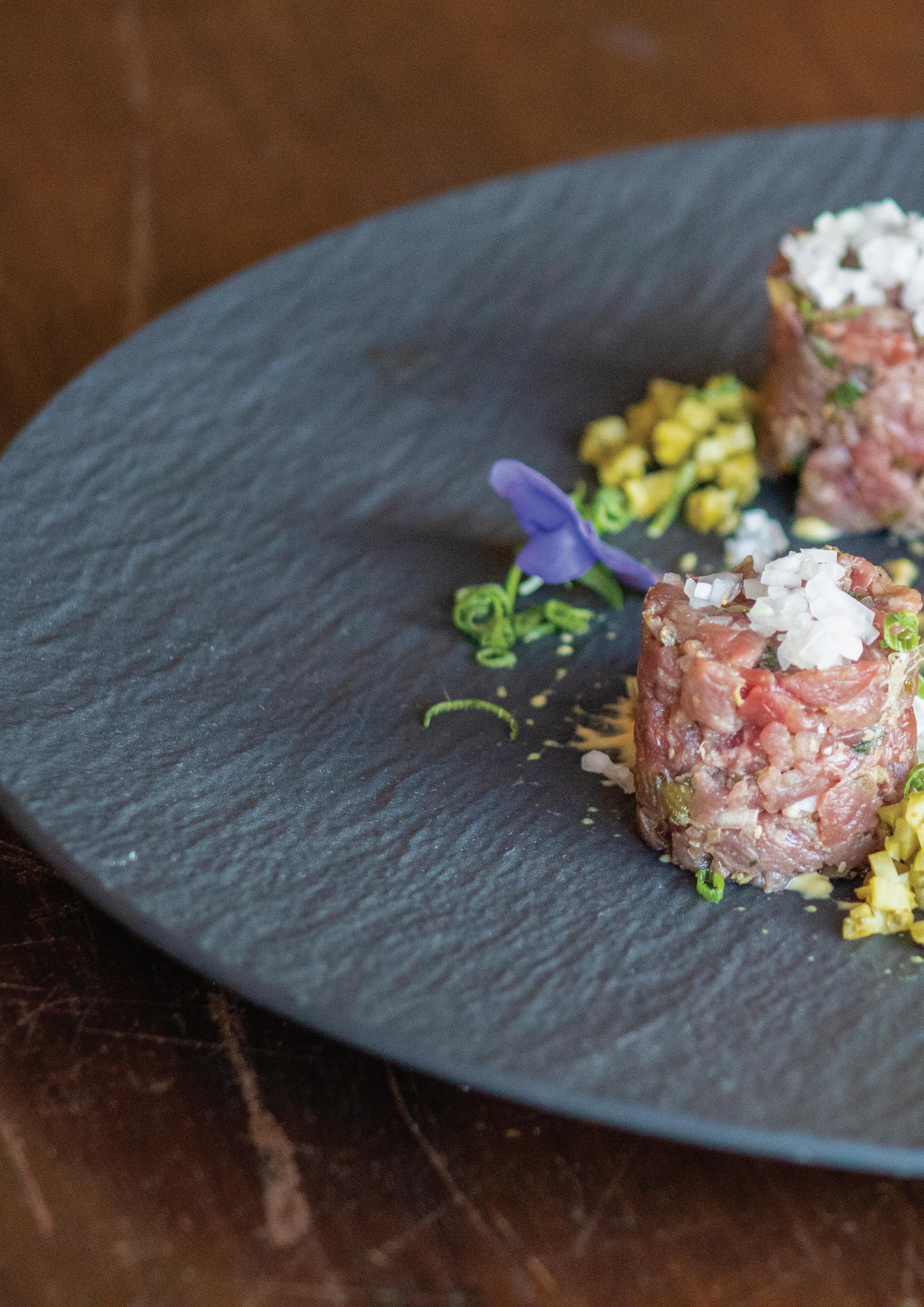
Fresh Horseradish, Quail Egg and Dijon
Yields 4
Ingredients
Beef Tartare
• 20 ounces trimmed Beef Tenderloin
• 6 Tablespoons Shallots (minced)
• 6 Tablespoons Capers (minced)
• 6 Tablespoons Chives (sliced)
• 6 Tablespoons Cornichons (minced)
• 6 Tablespoons Horseradish fresh grated on Microplane)
• 4 Quail Eggs
• 1/2 cup Dijon Mustard
• Kosher Salt (to taste)
• Black Pepper (freshly cracked, to taste)
• 12 Fennel Flowers (supplied by The Chef’s Garden)
• 1 clamshell assorted Violas (supplied by The Chef’s Garden)
Preparation
Beef Tartare
Slice and small dicethe beef tenderloin and place in a mixing bowl. Chef Note: Keep that mixing bowl on ice to keep beef tenderloin cold. Mince the shallot, capers, chives and cornichons. Chef Note: Keep all the ingredients separate. Peel and grate the fresh horseradish on a microplane. Mix 2 Tablespoons of shallots, capers, chives, cornichons, and horseradish into the beef tenderloin. Reserve the remaining ingredients for garnish. Mix 1 Tablespoon of the Dijon into the beef mixture and season with salt and pepper.


Assembly
Using a pastry brush tap the Dijon mustard onto the plate to make a circular design.
Using a 1 1/2 inch ring cutter make three towers on the plate with the beef tartare. Take the remaining ingredients and place small piles around each of the beef tartar cylinders.
Garnish the tops of the tartar with minced shallot and fennel flower.
Garnish the outer circle with assorted violas. Cut the top off the quail egg and separate the yolk. Place the quail yolk in the center of the dish and serve with toasted crostini.
Serve immediately after assembly.

Wine Match
Liquid Farm, Pinot Noir, Santa Barbara, California 2018
These ingredients are earthy, salty, spicy (horseradish/mustard), and rich. Pairing wines with tartare is very different than a filet mignon. Think of the texture, fat content, and flavors. I selected a wine that has some weight but can hold up to the mustard and horseradish’s boldness.
The spicy ingredients in this recipe need fruit, not tannin. Tannin exasperates the heat and makes it bolder.
~ Mary Schaffer, Assistant General Manager
Round Hill Club 115
Braised Short Rib with
Shiitake
Mushroom Polenta, Grilled Butternut Squash, Smoked Cherry Tomato, Shaved Black Truffle, Spicy Micro Greens
Yields 4
Ingredients
Beef Short Rib
• 4 Beef Short Ribs “Osso Bucco style”
• 3 Tablespoons Canola Oil
• 2 Onions
• 2 Carrots
• 3 stalks Celery
• 1/2 cup Seasoned Flour
• 2 Tablespoons Tomato Paste
• 1/2 bottle Red Wine
• 1 bunch Parsley
• 2 sprigs Rosemary
• 6 cloves Garlic (sliced thin)
• Beef Stock (cover short ribs)
Shiitake Mushroom Polenta
• 1 pound Shiitake Mushrooms (sliced)
• 3 sprigs Thyme
• 4 cloves Garlic (minced)
• 1/4 cup Extra Virgin Olive Oil
• 2 Tablespoons Butter
• 1 Cup Polenta
• 4 1/2 cups Chicken Stock
• 4 ounces Parmesan Cheese (grated)
Grilled Butternut Squash
• 1 Butternut Squash
• Olive Oil
• Salt and Pepper (to taste)
Smoked Cherry Tomatoes
• 1 pint Cherry Tomatoes
• Applewood Chips
• Olive Oil
• Salt and Pepper (to taste)
Garnish
• Fresh Black Truffles (shaved)
• Spicy Micro Greens (from the Chef’s Garden)
Preparation
Short Ribs
Lightly flour the short ribs with seasoned flour and sear on all sides until golden brown.
Add the onions, carrots, and celery to the pot and cook until the onions start to caramelize. Add the tomato paste and cook for an additional 2-3 minutes. Add the red wine and sliced garlic then reduce by half. Add the herbs and stock to pot and bring to a boil. Cover and reduce to a simmer and cook for 2-2 1/2 hours on low heat until tender. Transfer the short ribs to platter and reduce the sauce until you hane the proper consistency.
Shiitake Mushroom Polenta
Caramelize the shiitake mushrooms in a pot with oil over medium heat. Chef Note: Do not add salt until mushrooms start to caramelize. Season with salt and pepper and add the garlic and thyme. Sauté for 2-3 more minutes over a medium low heat. Add the chicken stock and butter to the pot and whisk until the butter is melted. Slowly add polenta to the pot, stirring constantly with a good pinch of salt to season. Cook for 25-30 minutes over a low heat until polenta starts to pull away from the side of the pot. Finish polenta with parmesan cheese and olive oil.
Butternut Squash
Peel the butternut squash and slice into 1/2 inch thick rings. Clean the seeds out of the bottom half and use a ring cutter to punch out circles in the top half. Season with the oil, salt and pepper. Grill until you get some char marks and transfer to a 350 °F oven to finish cooking.
Golf Kitchen Magazine 116

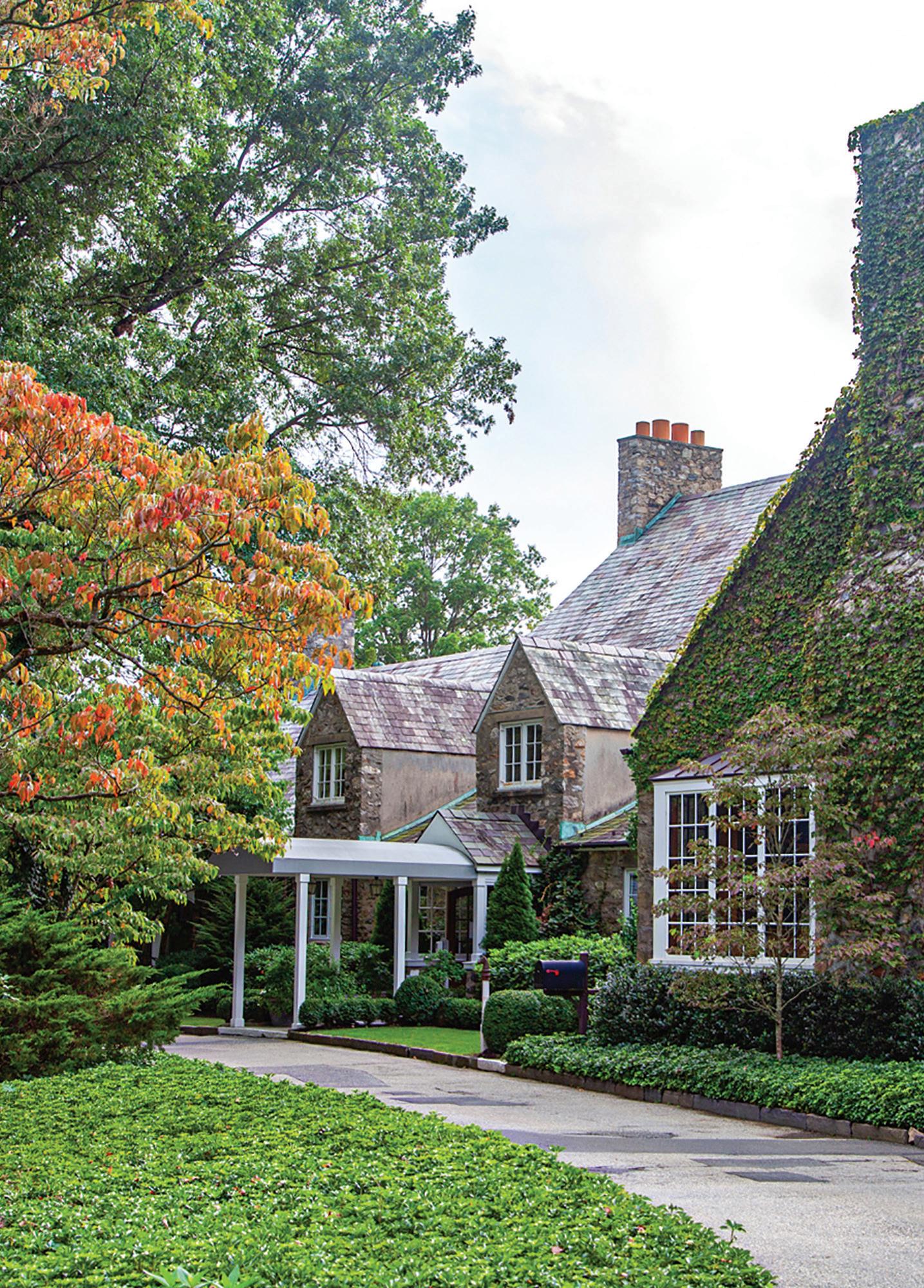 RECIPE BY PETER ZOOLE
RECIPE BY PETER ZOOLE
Smoked Cherry Tomatoes
Poke 10-15 holes in each cherry tomato with a small needle. Toss the tomatoes with the oil, salt and pepper and smoke at 225 °F until the tomatoes are just starting to get soft. Chef Note: If you do not have a smoker you can toss the tomatoes in 1 teaspoon of liquid smoke and cook in a 225 °F oven until done.
Assembly
Place a spoonful of polenta in the bottom of a bowl. Place a short rib on top of the polenta. Cover with some of the reduced braising liquid. Put 2-3 rings of butternut squash around the bone from the short rib. Dress the micro greens with olive oil, salt and fresh black pepper. Add to the side of the short rib. Shave the fresh black truffles over entire dish. Serve immediately after assembly.
Wine Match
Ferraton, Montmain, Cote Rotie, Rhone, France 2015
In this recipe, I can taste the short ribs, mushrooms, truffles, and smoke notes. I want a wine that is earthy and rich because short ribs are anything but delicate. The polenta is creamy and buttery; thus, I have selected a pairing from France’s Rhone region. You’ll get the weight and the earthiness, but the fruit will be subtle.
~ Mary Schaffer, Assistant General Manager

Round Hill Club 119

Beet Salad with Goat Cheese, Charred Onion, Frantoia Extra Virgin Olive Oil, Micro Sorrel, Cocoa Crumble, and Smoked Sea Salt
Yields 4
Ingredients
Baby Beets
• 1 pound Mixed Baby Beets approximately 1 inch diameter (Chefs Garden)
• 2 ounce Champagne Vinegar (per bag)
• 1 ounce Beef Jus1 sprig Thyme (per bag)
• 10 grams Salt (per bag)
• 1/2 grams fresh ground White Pepper (per bag)
• 28 grams whole butter (per bag)
Charred Onion
• 2 whole Red Onions (peeled)
• Canola Oil (as needed)
• Cracked Black Pepper (to taste)
• Kosher Salt (to taste)
Cocoa Crumble
• 95 grams Softened Butter
• 30 grams Cocoa Powder

• 95 grams Flour
• 85 grams Sugar
• 6 grams Maldon Salt
Round Hill Club 121
Other Ingredients
• 4 ounces Goat Cheese (crumbled)
• 2 ounces Frantoia Extra Virgin Olive Oil
• 1 ounce Vincotto
• 1 clamshell Mixed Lucky Sorrel Leaves (Chefs Garden)
• 1 Tablespoon Quality Smoked Sea Salt (Saltopia)
• 1 clamshell Mixed Beet Blush (Chefs Garden)
Preparation
Beets
Trim the tops of the beets and scrub with new green scrub pad to remove dirt and outer layer of skin. Separate the beets by type into separate vacuum seal bags. Add rest of ingredients to each bag from above and seal each bag.
Sous Vide at 212 °F for 25 minutes until beets are tender. Cool the vacuum bags in an ice bath. Remove the beets from the bags and trim up the tops and cut in them in half.
Season with small amount of smoked sea salt.
Charred Onion
Slice the onion into 1/2 inch thick rings.
Season with oil, salt and pepper.
Sear the onion slices on an extremely hot plancha until they are black and charred. Chef Note: Use a cast iron skillet if needed.
Flip the onions over and lightly char the other side. Remove the onions and cool. Separate rings and reserve for plating.
Cocoa Crumble
Blend all the ingredients together in mixer with a paddle attachment.
Spread onto a sheet tray to 1/4 inch thick.
Bake at 350 °F for 35-45 minutes. Chef Note: The edges should be completely dry and starting to change color. Cool at room temperature.
Blend in a food processor until it is a fine crumble.
Assembly
Make a pile of cocoa crumble five inches long and 1 inch wide on a plate.
Duplicate a pile of crumbled goat cheese next to the cocoa crumble.
Arrange the beets, charred onion, and beet blush on top and bottom of plate. Serve immediately after assembly.
Wine Match
Best pairing: Arterberry Maresh, “Maresh Vineyard”, Pinot Noir, Dundee Hills, Oregon 2015
These ingredients are all earthy. You also have a richness from the olive oil and a bit of salt. I would look for a wine with tannin to soften the salt and oil. I would also look for wine with good acidity to lift the dish and complement the goat cheese.
Mary Schaffer, Assistant General Manager
Golf Kitchen Magazine 122


CLUBHOUSE COCKTAILS
“Balty Barrel” Aged Manhattan Ingredients
1 - one liter Bottle Clyde May’s Bourbon
1/2 - one liter Bottle Antica Sweet Vermouth
1/4 - 750ml Bottle Meletti Amaro

10 dashes Peychauds Bitters
Garnish
Cherries
Preparation
Pour all of your ingredients into on Oak Barrel. Let the ingredients set for at least two weeks, and up to 2 months. Pour 31/2 ounces of the Barrel over a large cube in a rocks glass. Garnish with cherries.
Cheers!
Recipe by Trey Bayliss Assistant Manager Baltusrol Golf Club
Clubhouse Cocktails 125
CLUBHOUSE COCKTAILS
Bow and Arrow
Botanical Champagne
Cocktail Ingredients
1 ounce Ketel One Botanical Peach Orange Blossom
0.25 Ounce Merlet Trois Citrus
0.5 Ounce Fresh Lemon Juice Kenwood “Yulupa” Sparkling
Garnish Orange Twist
Preparation
Shake all ingredients with ice and strain into chilled coupe glass.

Top with Kenwood sparkling.
Garnish with orange twist.
Cheers!
Recipe by Steve Pinheiro
Restaurant Manager at The Creek Club
Reynolds Lake Oconee
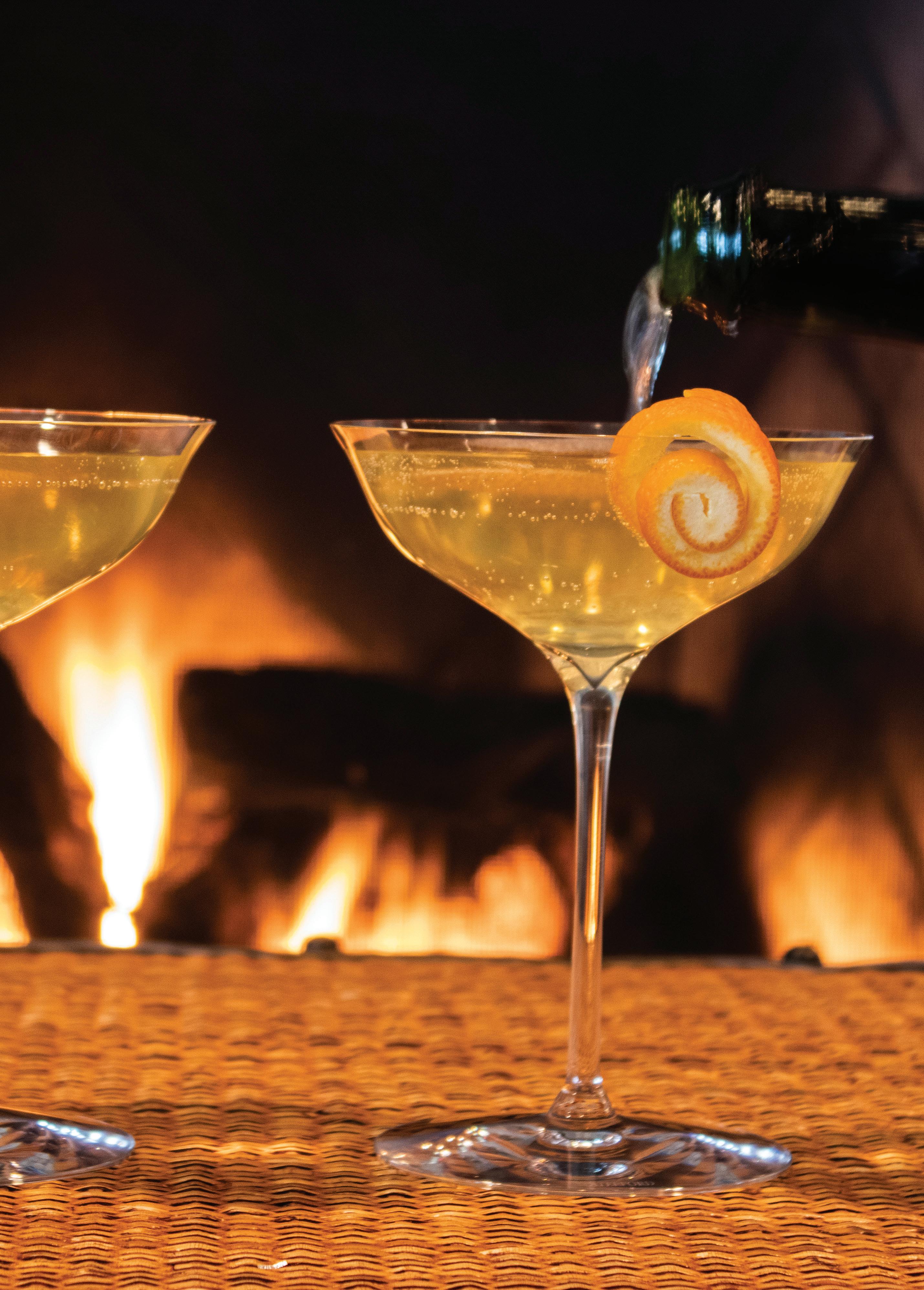
Get Fit With Fred
Author oF the restAurAnt diet
Fred Bollaci is a true renaissance man. As an international influencer and diet and weight loss strategist, Fred is also a lifestyle and weight loss coach, motivational and inspirational speaker, and healthy gourmet food and beverage consultant to the hospitality industry. He is also food and travel writer and blogger, and Sommelier (Court of Master Sommeliers), and Food, Wine, Travel and Art Writer for VENU Magazine, one of the nation’s leading contemporary culture and luxury lifestyle magazines.
Fred is also a practicing Trusts and Estates Attorney in Florida, a Florida relocation specialist and a Florida luxury residential real estate broker who works specifically with buyers to help find their dream home.
Since childhood, Fred has enjoyed a gourmet lifestyle of healthy gourmet food and international travel and is now known as “The Healthy Global Gourmet.” Fred lost 150 pounds in one year while living “La Dolce Vita” in 2009-10 and has since helped many people succeed in their weight loss journeys. This year, due to the challenges presented by COVID-19, and the demand for remote lifestyle coaching during the pandemic, Fred launched his popular 1:1 Virtual Diet & Lifestyle Mentor Coaching Program, where clients receive daily messenger support from Fred, a private weekly progress call via Zoom, and a customized weight loss plan. “Through his personal experience and interaction with so many people, Fred has the knowledge to support and guide you with your diet and with your mental attitude. But most of all he has the right heart for this work. Fred is a coach, a friend and a positive, kind soul.” Michaela, (Coaching Client)
Fred has written two books about his weight loss, offering a unique four-phase approach and valuable insight and wisdom.The first edition of The Restaurant Diet, How to Eat Out Every Night and Still Lose Weight, is a gourmet cookbook, diet book, and travel guide. The Restaurant Diet, A Spiritual Journey of Self Discovery features 100 pages of brand new personal content, both are must reads for anyone who enjoys food and wants to lose weight without sacrificing the enjoyment of dining out or cooking gourmet meals at home. Both books are available on Amazon, and wherever books are sold.
Today, Fred Bollaci feels great, and enjoys a variety of activities, especially adventure travel, writing, cooking, dining, fine wine, photography, and his two dogs. Fred is a native of Long Island, New York, and currently resides in Sarasota, Florida.
Growing up in an Italian-American family of gourmands in the New York area, Fred was exposed to a gourmet lifestyle from a young age. He frequently traveled in America and abroad, dining in many celebrated establishments. Part of that lifestyle was growing up with not only family in the restaurant business that loved to cook, he also had family in the golf business and grew up belonging to a top club on Long Island. Having lived this lifestyle for four decades, Fred is accustomed to the decorum and privacy that make the private club experience and membership so special. Today, Fred works 1:1 with clients from all over the world to share the success he has worked so hard to attain. In fact, Fred has lectured and signed books at many clubs and works with members he has met at his events, who have come to value the level of attention and discretion Fred provides 1:1 to his Diet & Weight Loss clients. Having lost 150 pounds in 2009-10 and working to keep the weight off, Fred brings to the table a wealth of wisdom, experience, and compassion and has helped hundreds of clients lose thousands of pounds and transform their lives!
Golf Kitchen Magazine 128
www.fredbollacienterprises.com

You are cordially invited to join Fred on the journey to a new and better you! Imagine having the freedom of being able to go anywhere and do anything and not feel self-conscious? Imagine the feeling of smiling when you look in the mirror? Imagine feeling proud of yourself, empowered, peaceful, serene, content, and even happy? Imagine being able to enjoy many of the foods you love without the guilt? Imagine being able to enjoy exercise as a vital and beneficial part of life? Imagine being able to work with someone ho has seen and heard it all, who has helped many people achieve success, and to be able to do it remotely, from the comfort and privacy of your own home?
Today, in this age of COVID-19, more than ever, people need support, an ally, a friend, a mentor, someone who understands where they are and what they’re going through, a partner to help them navigate the amazing journey to total freedom from dieting, overeating, bingeing, purging, and self-loathing once and for all!

Space in the Coaching Program is limited to ensure clients receive the attention they deserve.
Call Fred (561)789-0047, private message
Fred on Facebook @FredBollaci or @Fredbollacienterprises, or e-mail info@fredbollacienterprises.com
TO SCHEDULE A FREE 15-Minute Call to learn how Fred can help you achieve amazing results and to reserve your space today!
For more information, visit www.fredbollacienterprises.com and www. fredbollacilaw.com
SPECIAL PRICING: Through April 2021: Pay for TWO MONTHS, get the THIRD MONTH FREE! The perfect way to get in shape in time for the summer and lose your COVID and quarantine weight!
Buy Now on Amazon
Advertorial


























 The 16th green at Great Waters. Image Evan Schiller, courtesy Reynolds Lake Oconee.
The 16th green at Great Waters. Image Evan Schiller, courtesy Reynolds Lake Oconee.












 The Landing #4 and #5.
Image by Evan Schiller, courtesy Reynolds Lake Oconee.
The Landing #4 and #5.
Image by Evan Schiller, courtesy Reynolds Lake Oconee.







 The bar at The Creek Club.
Image courtesy Reynolds Lake Oconee.
The Creek Club dining room.
Image courtesy Reynolds Lake Oconee.
The bar at The Creek Club.
Image courtesy Reynolds Lake Oconee.
The Creek Club dining room.
Image courtesy Reynolds Lake Oconee.
























 Michael McCarthy, CEO, Addison Reserve Country Club
Michael McCarthy, CEO, Addison Reserve Country Club









 The Baltusrol Clubhouse
Image by Evan Schiller
The Baltusrol Clubhouse
Image by Evan Schiller










 The Terrace at Baltusrol Golf Club in the evening
The Terrace at Baltusrol Golf Club in the evening


 The second hole of Baltusrol’s Lower Course. Image by Evan Schiller.
The second hole of Baltusrol’s Lower Course. Image by Evan Schiller.



 The Eldridge Room at Baltusrol Golf Club
The Eldridge Room at Baltusrol Golf Club



 The Trophy Room displays Baltusrol’s renowned championship history.
The Wine Cellar at Baltusrol Golf Club
The Trophy Room displays Baltusrol’s renowned championship history.
The Wine Cellar at Baltusrol Golf Club
 Juan Pablo de la Sota Riva Leal, Executive Chef at Royal Poinciana Golf Club
Image by Stephanie Starr
Juan Pablo de la Sota Riva Leal, Executive Chef at Royal Poinciana Golf Club
Image by Stephanie Starr




























 Dominic Calla in action in the Round Hill Club kitchen.
Image by Michael J. Fiedler
Dominic Calla in action in the Round Hill Club kitchen.
Image by Michael J. Fiedler





 RECIPE BY PETER ZOOLE
RECIPE BY PETER ZOOLE










